This document provides information about networking basics including client-server computing, sockets, TCP, UDP, ports, proxies, and internet addressing. It discusses how client-server computing uses clients and servers, how sockets provide endpoints for communication, and how TCP and UDP are used for reliable and unreliable data transmission respectively. It also covers common port numbers, how proxies cache requests and act as intermediaries, and how internet addresses are represented in IPv4 and IPv6 formats. The document is intended as a teaching aid for a class on advanced Java programming and networking concepts.
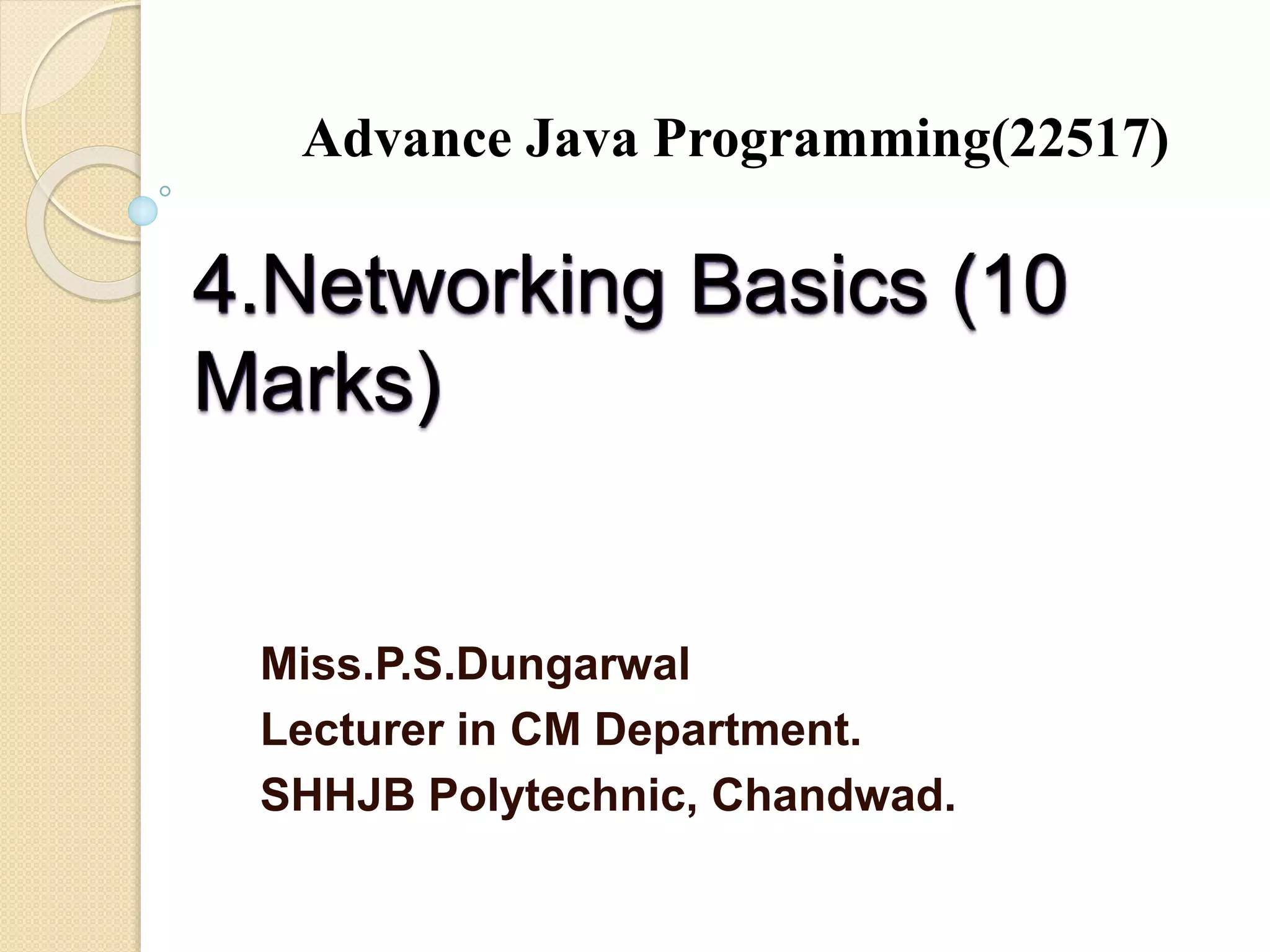
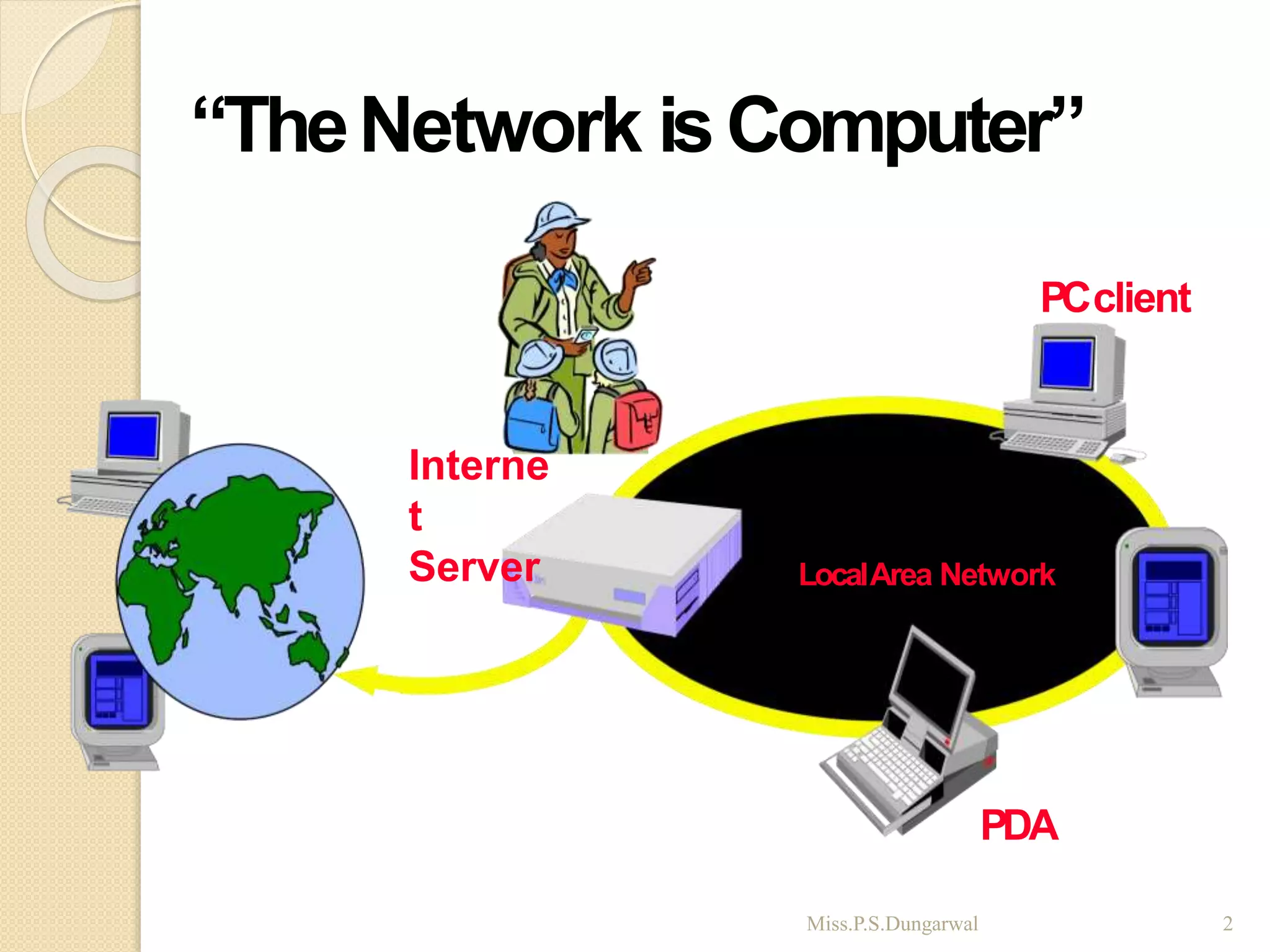
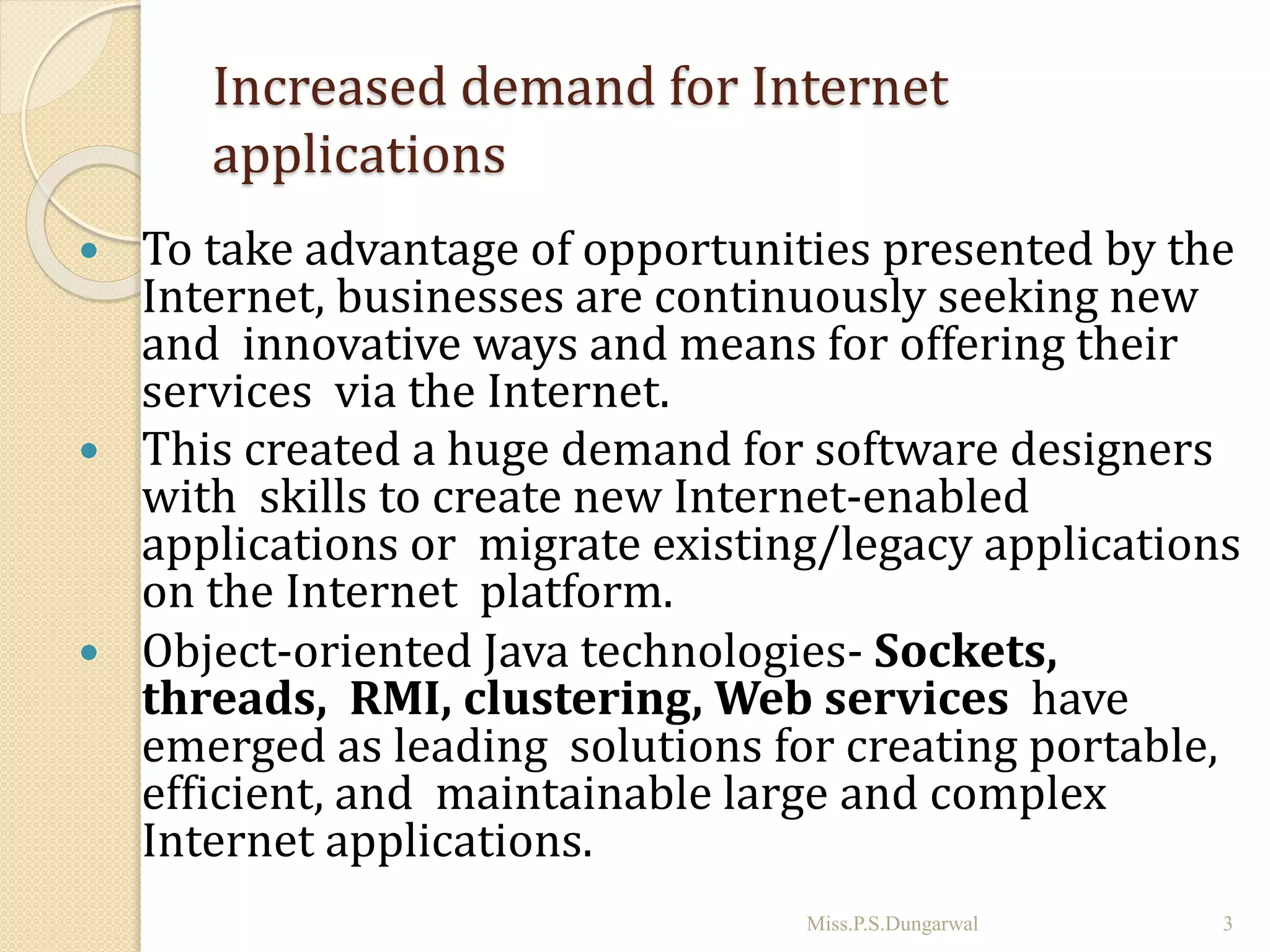
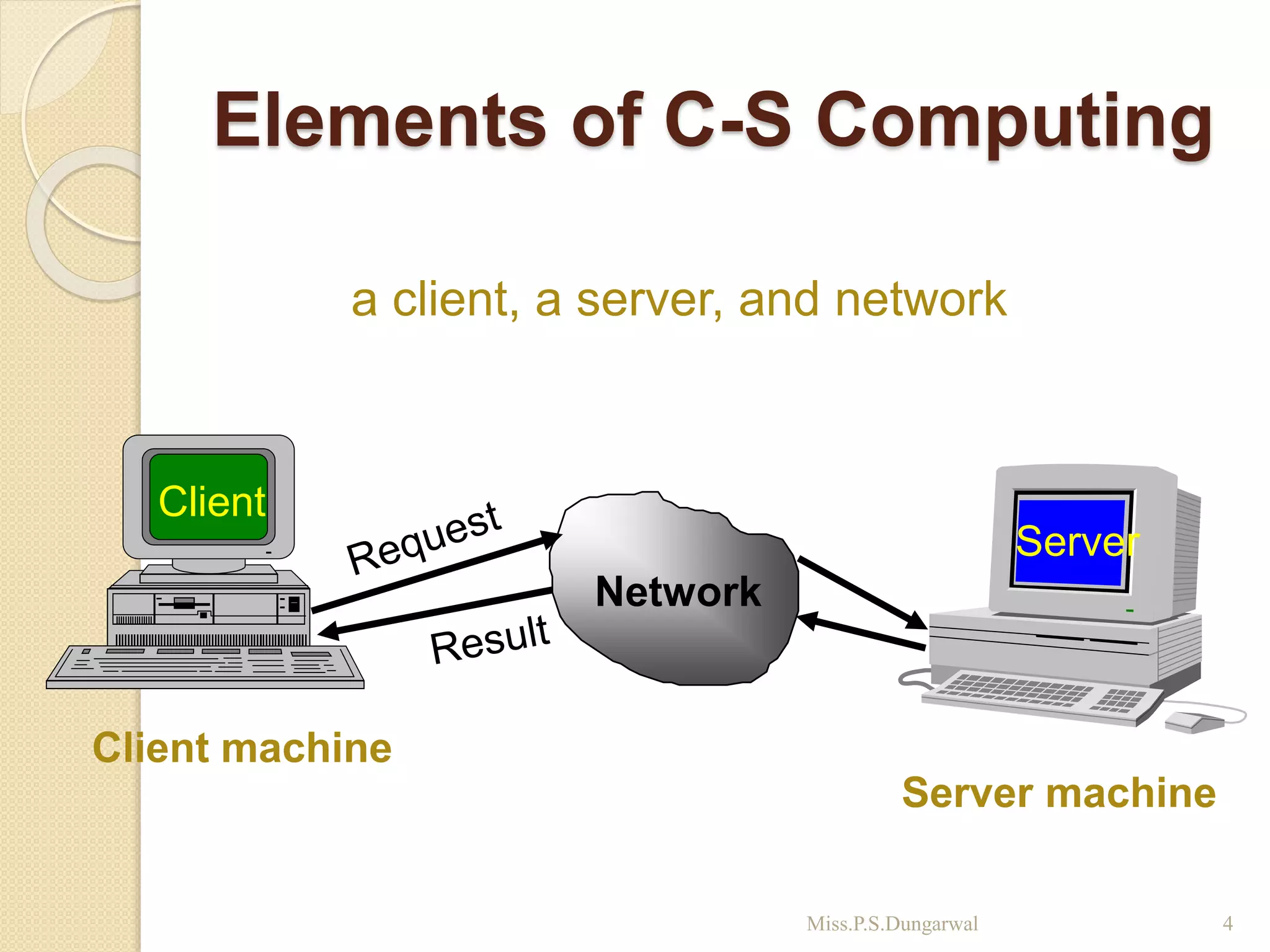
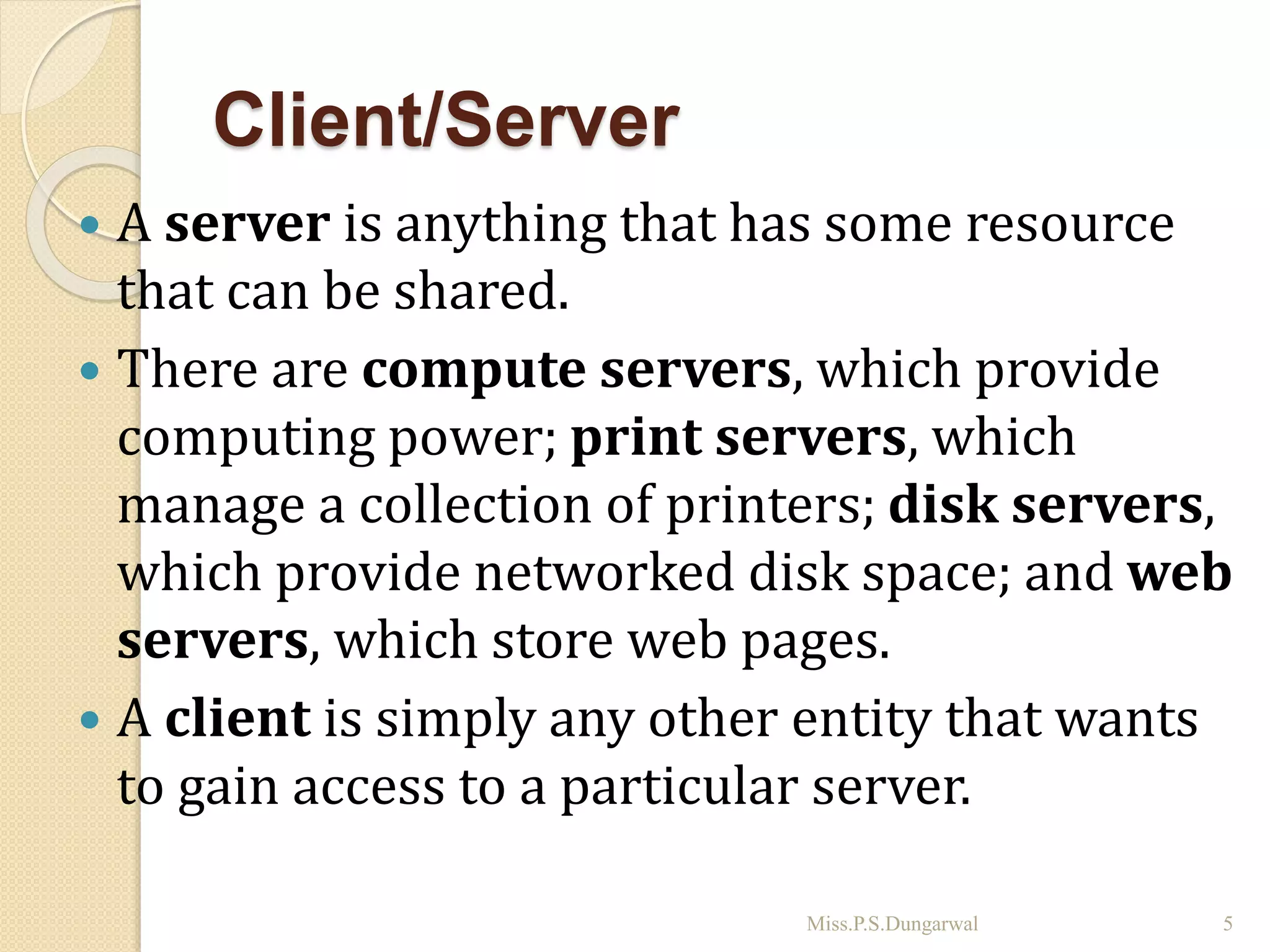
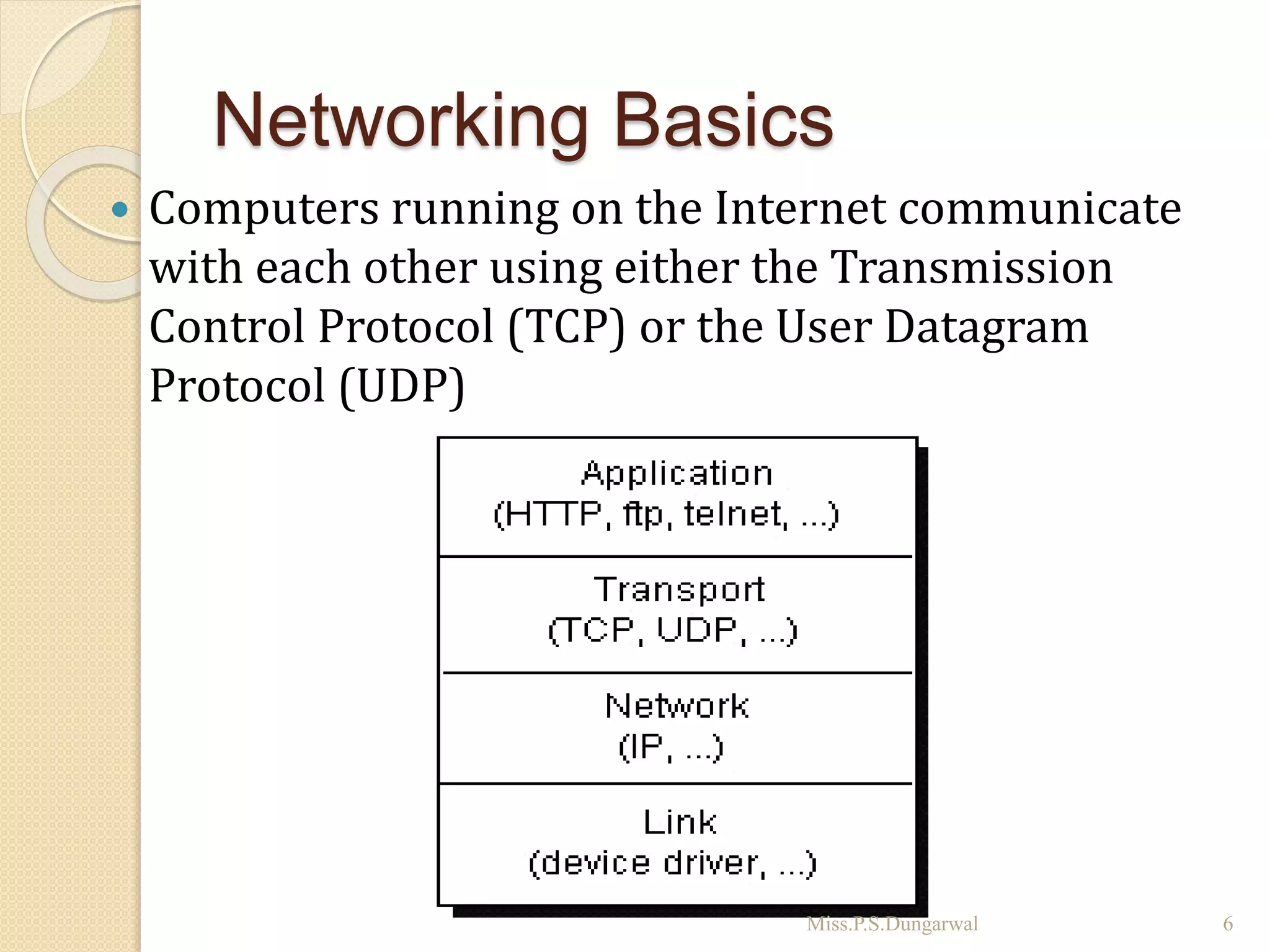
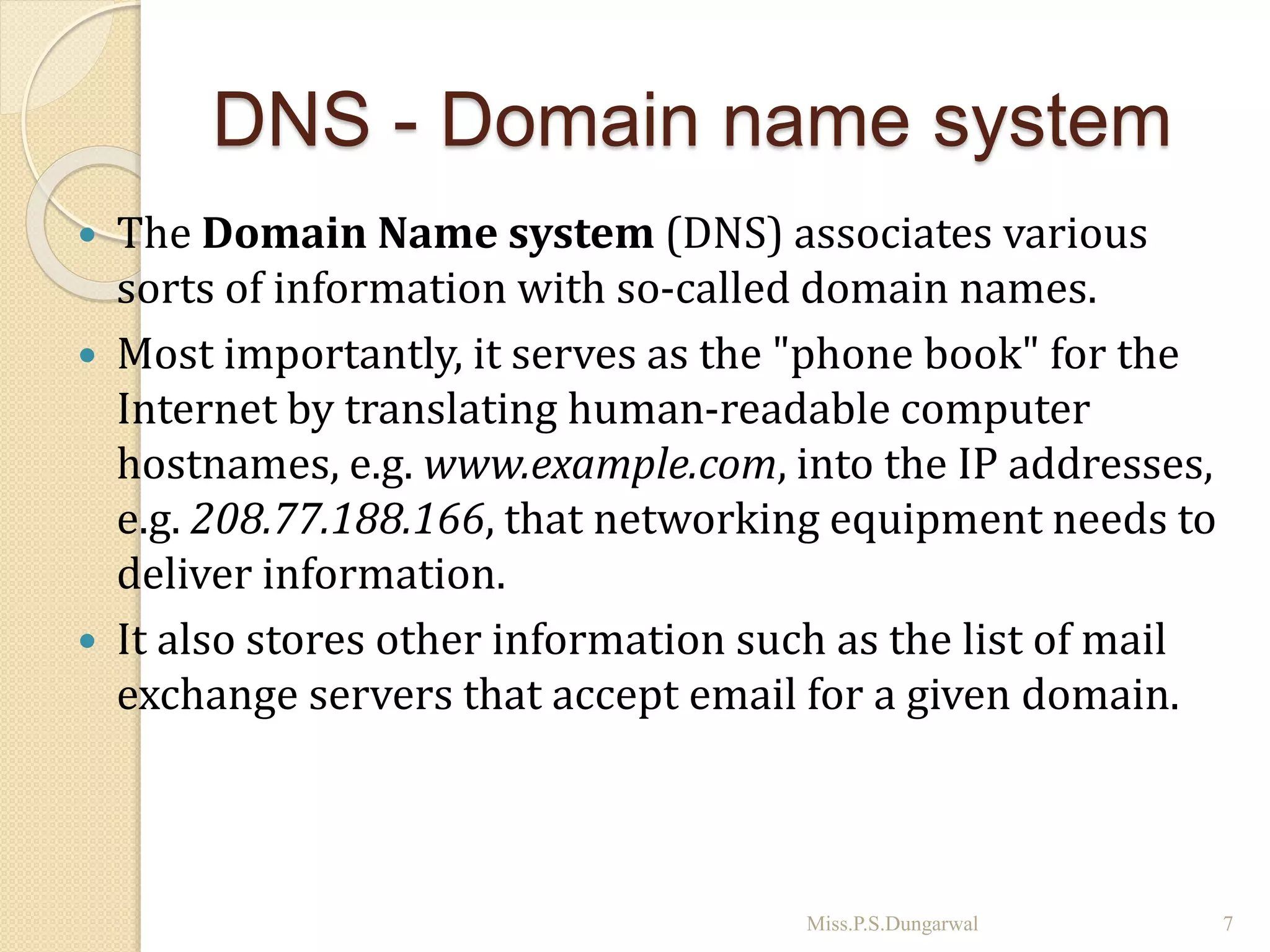
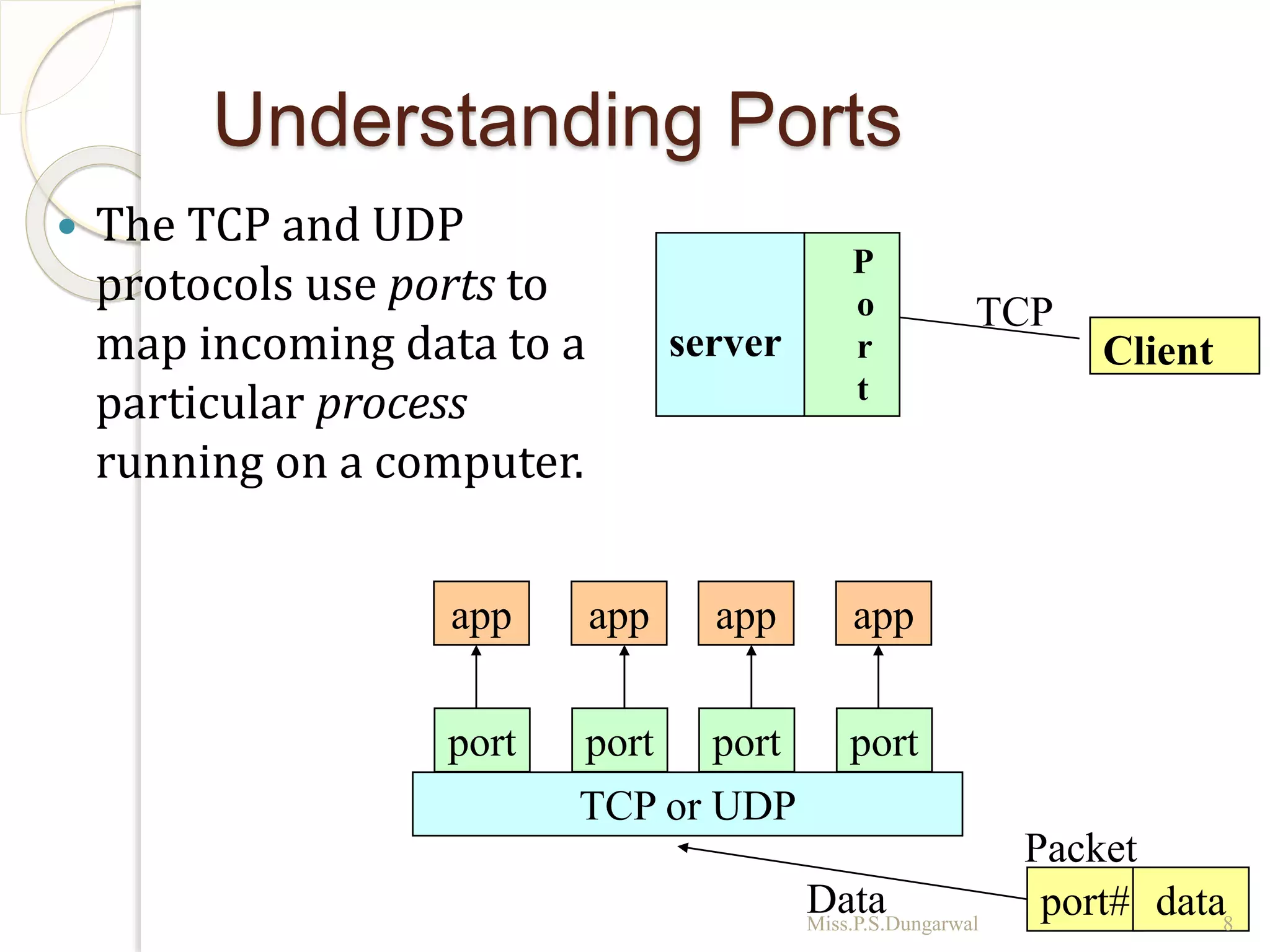
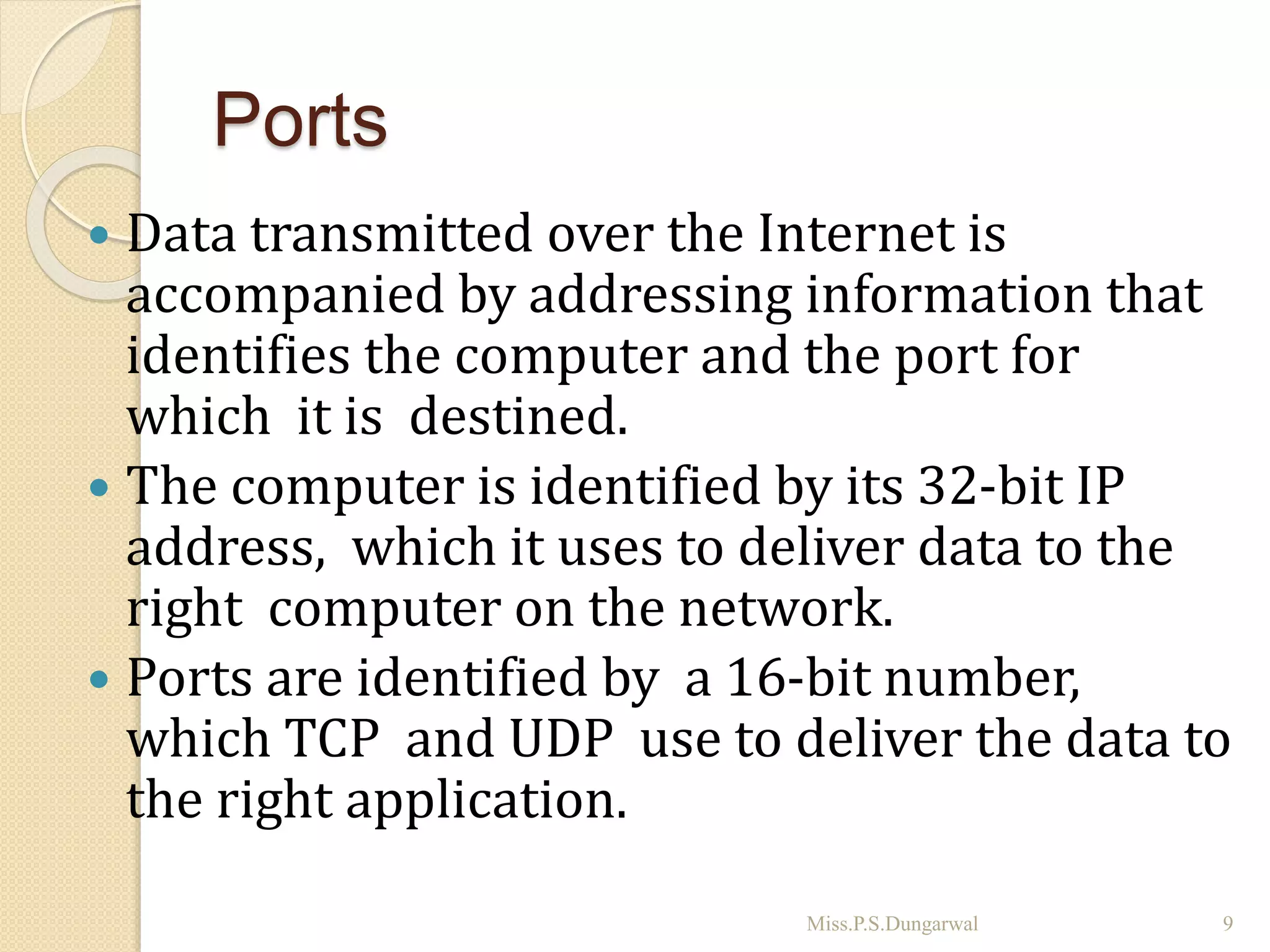
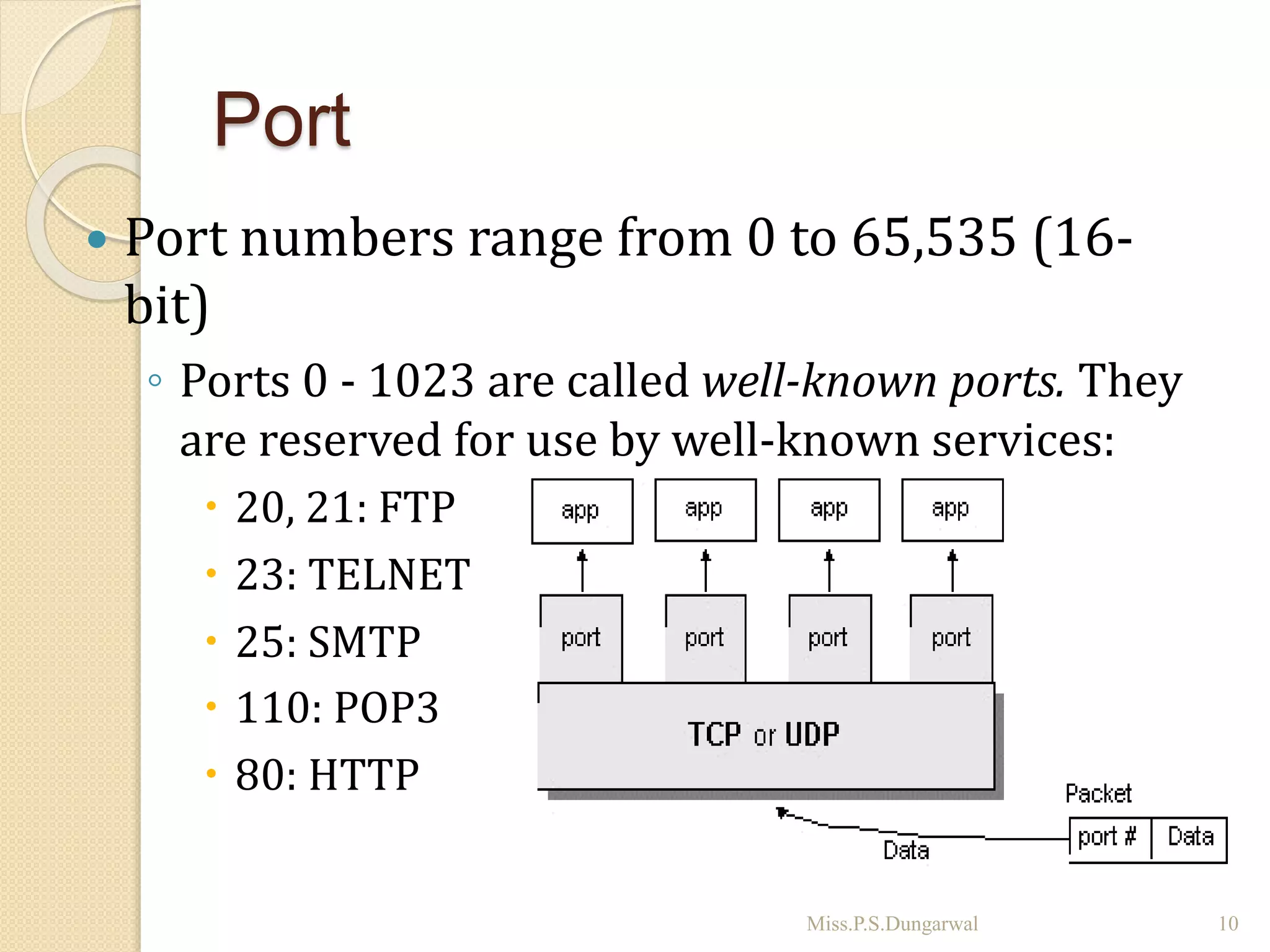
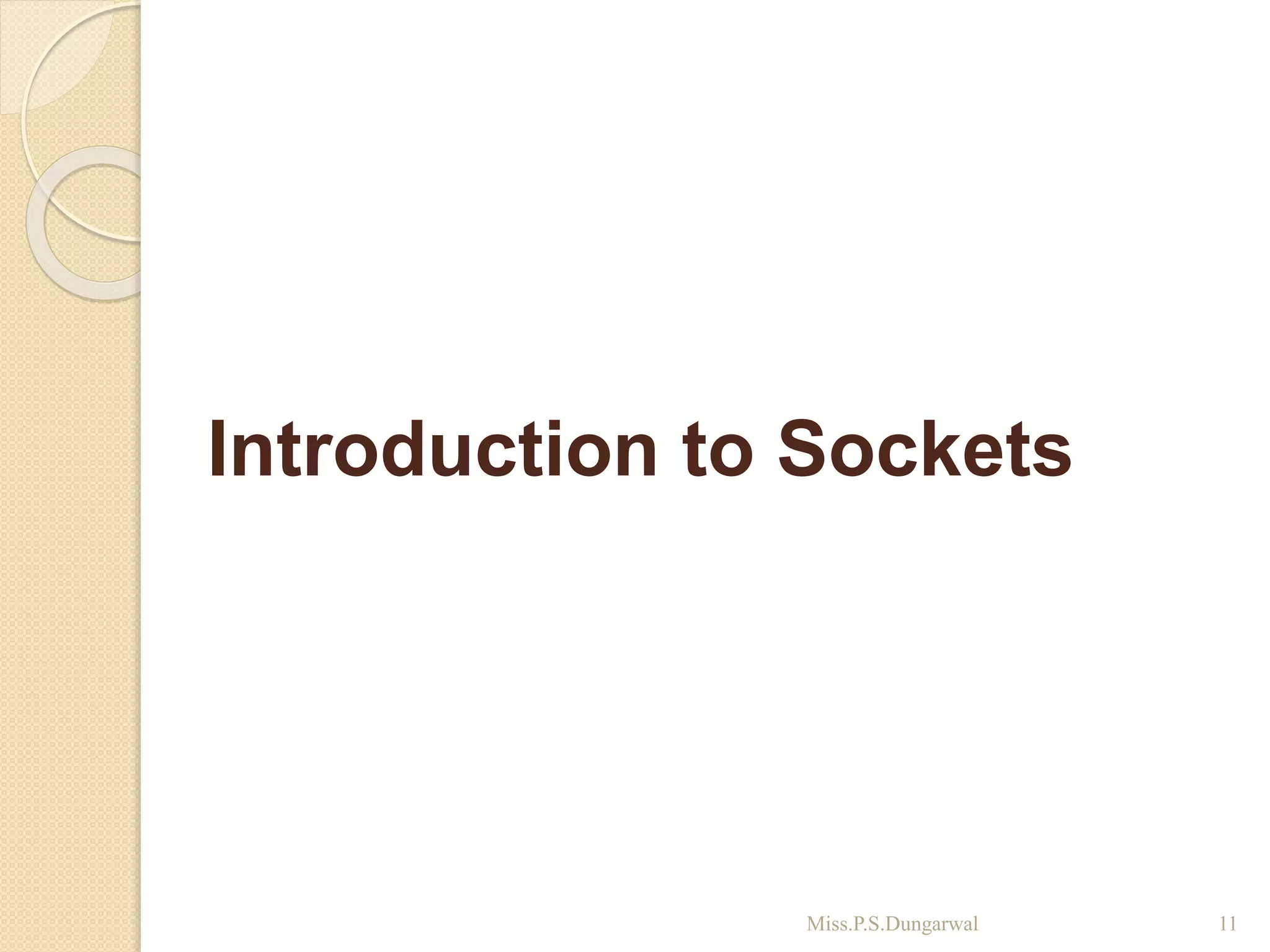
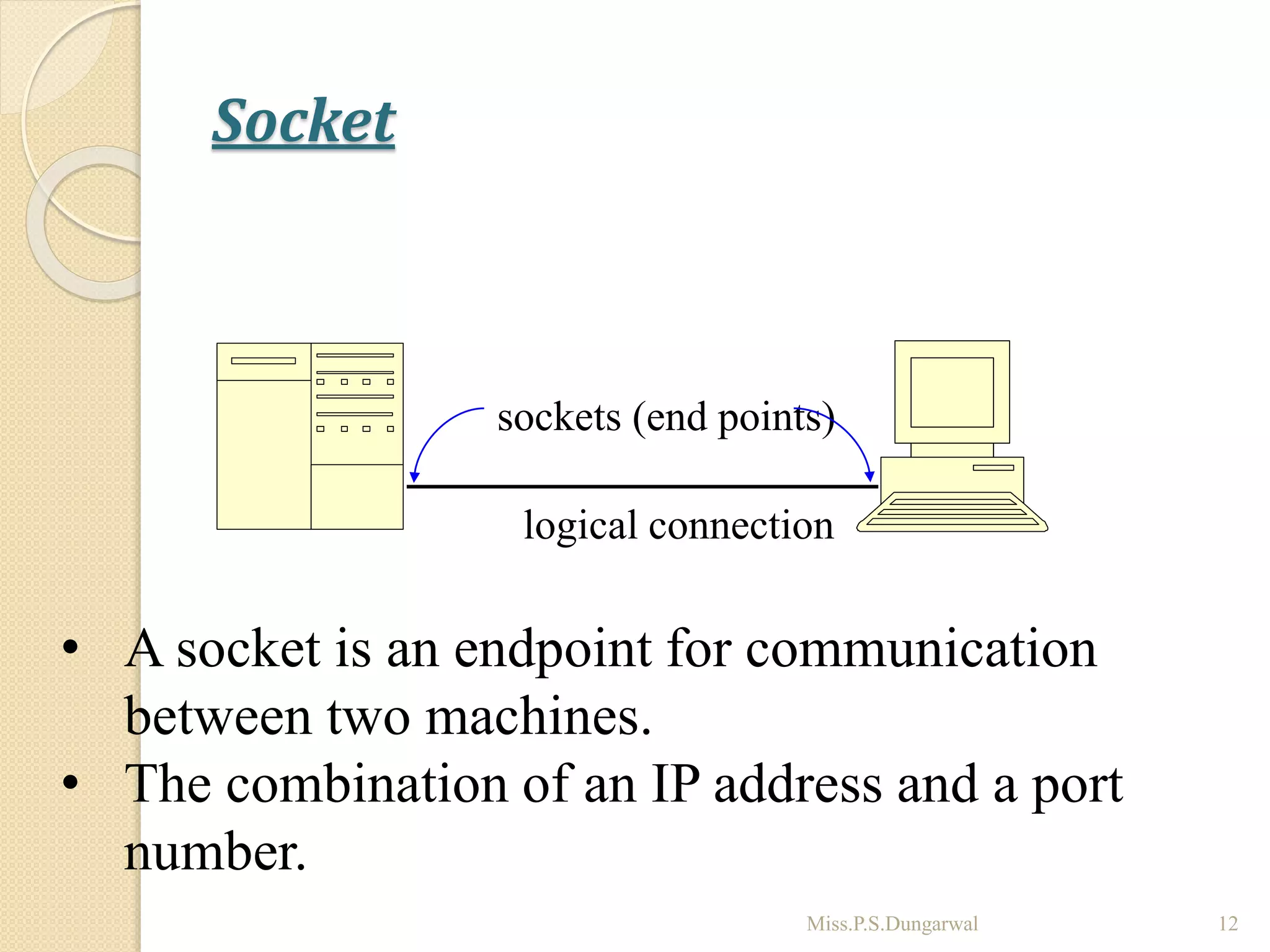
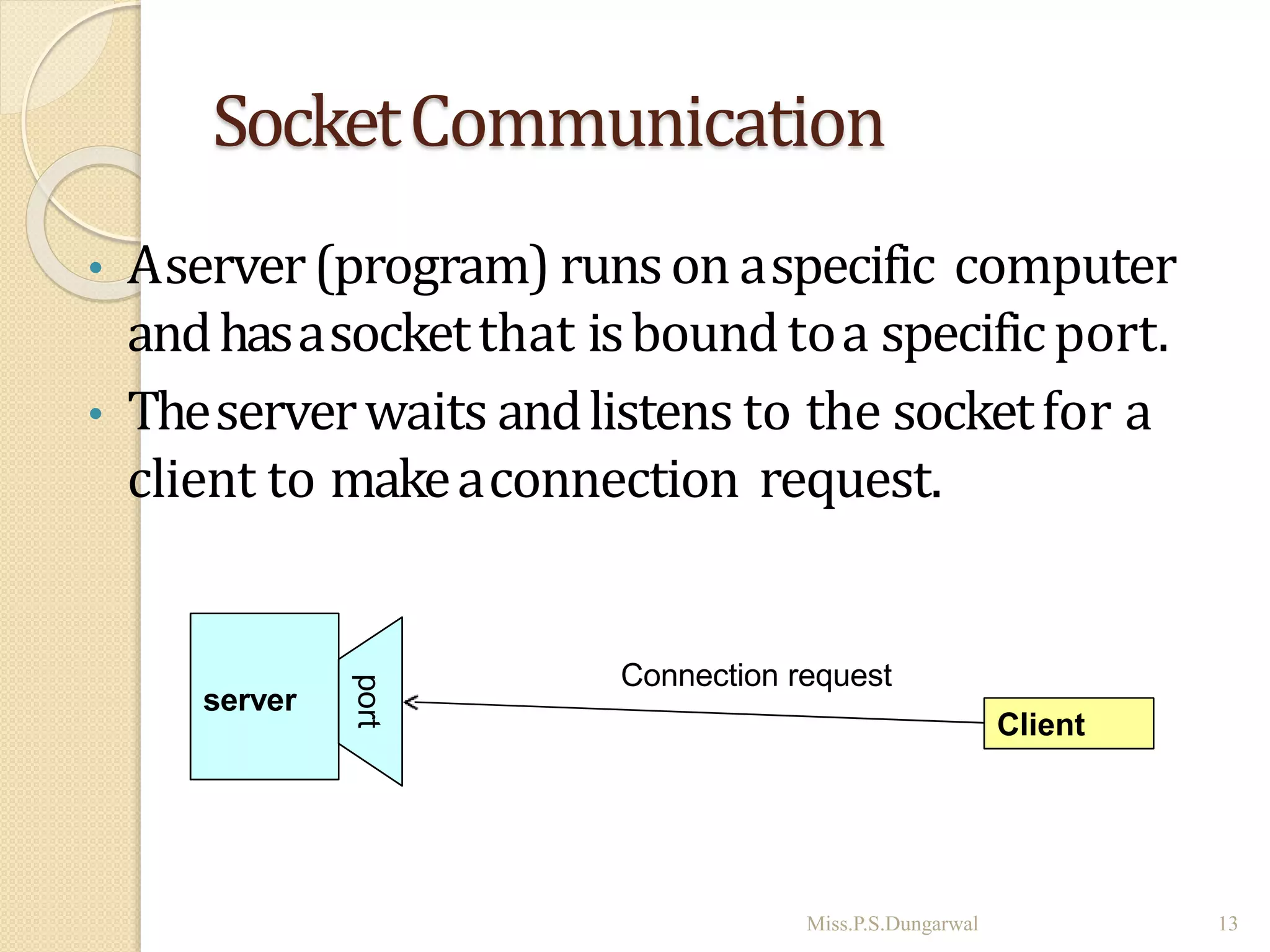
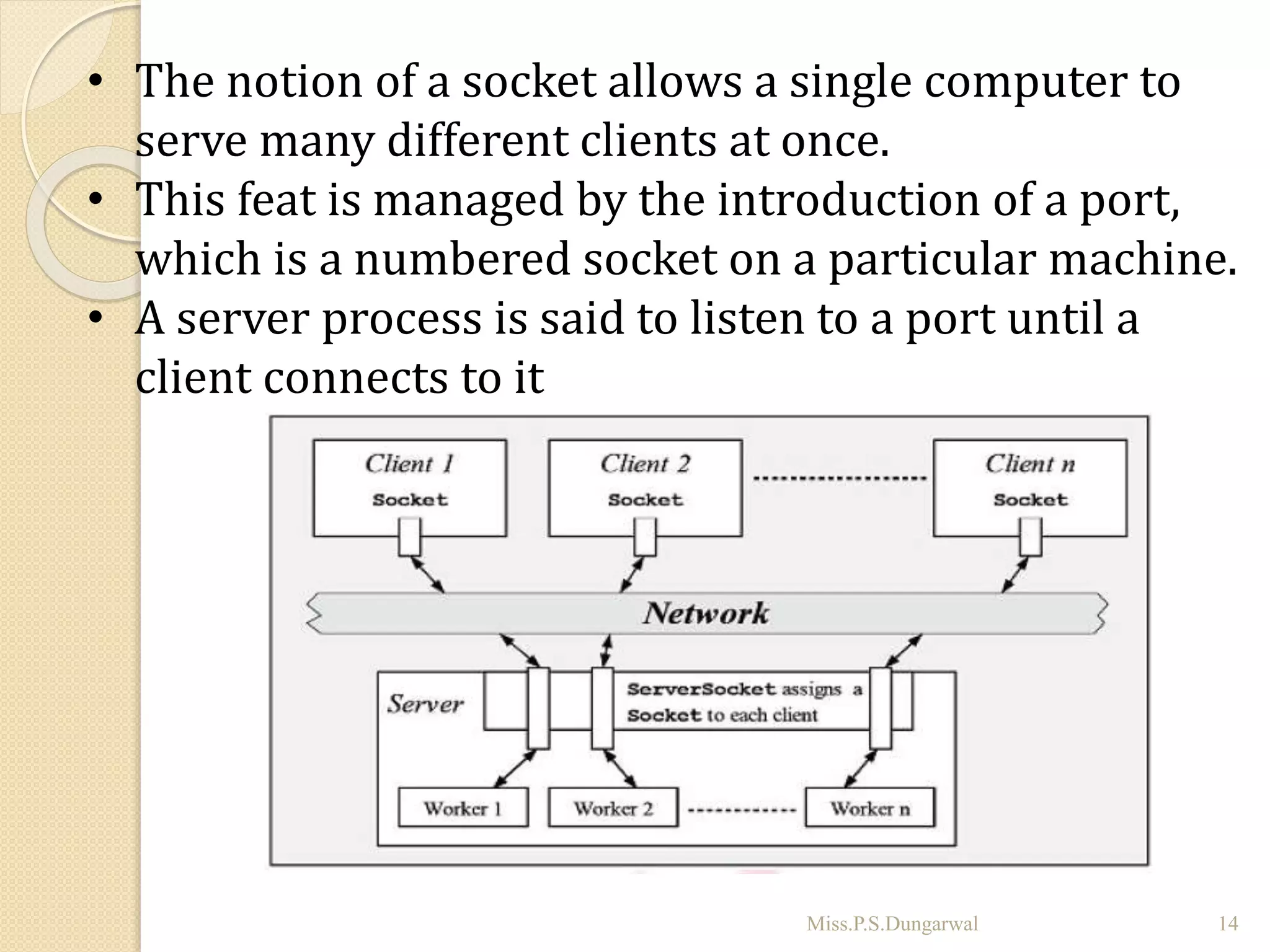
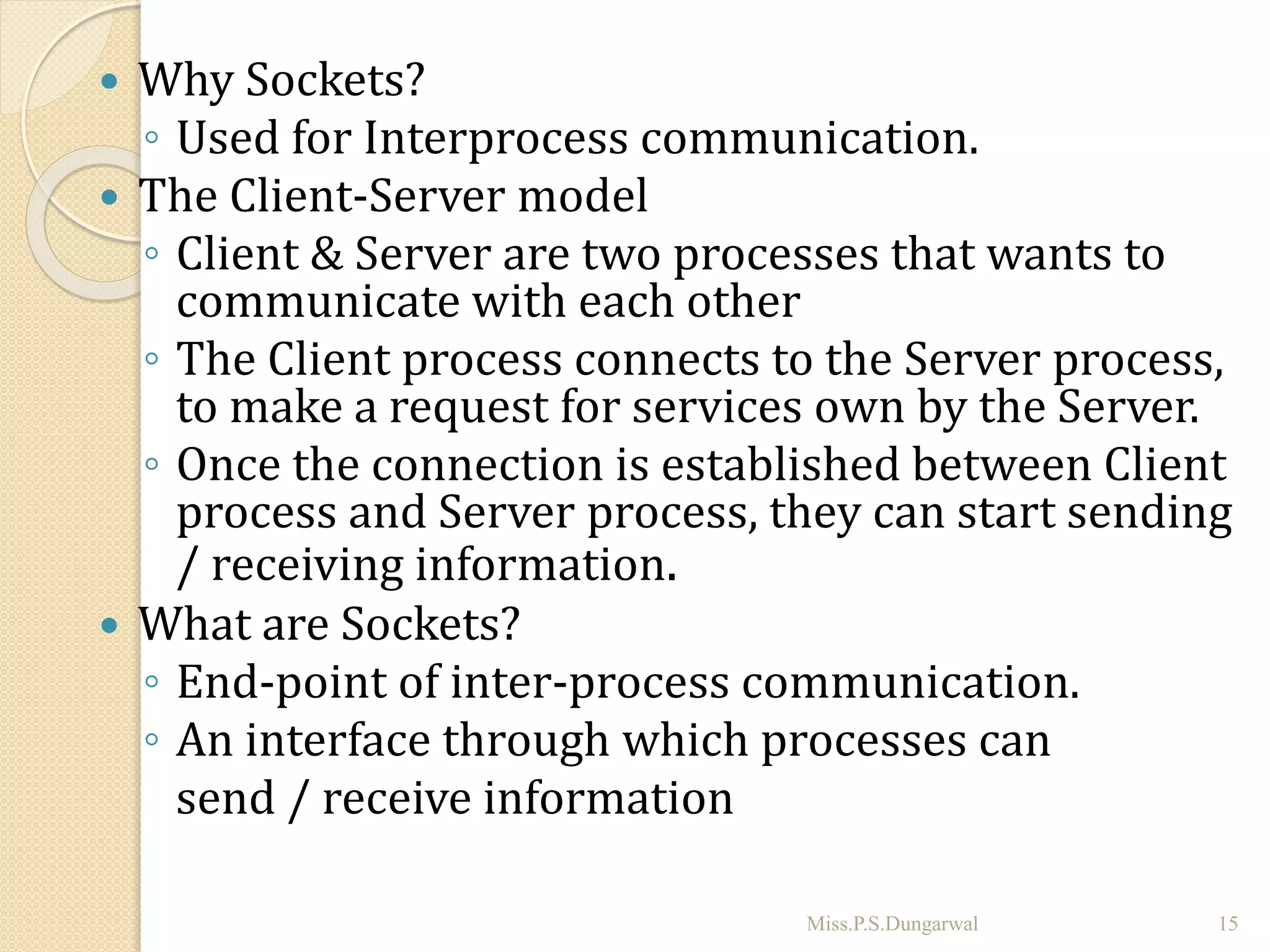
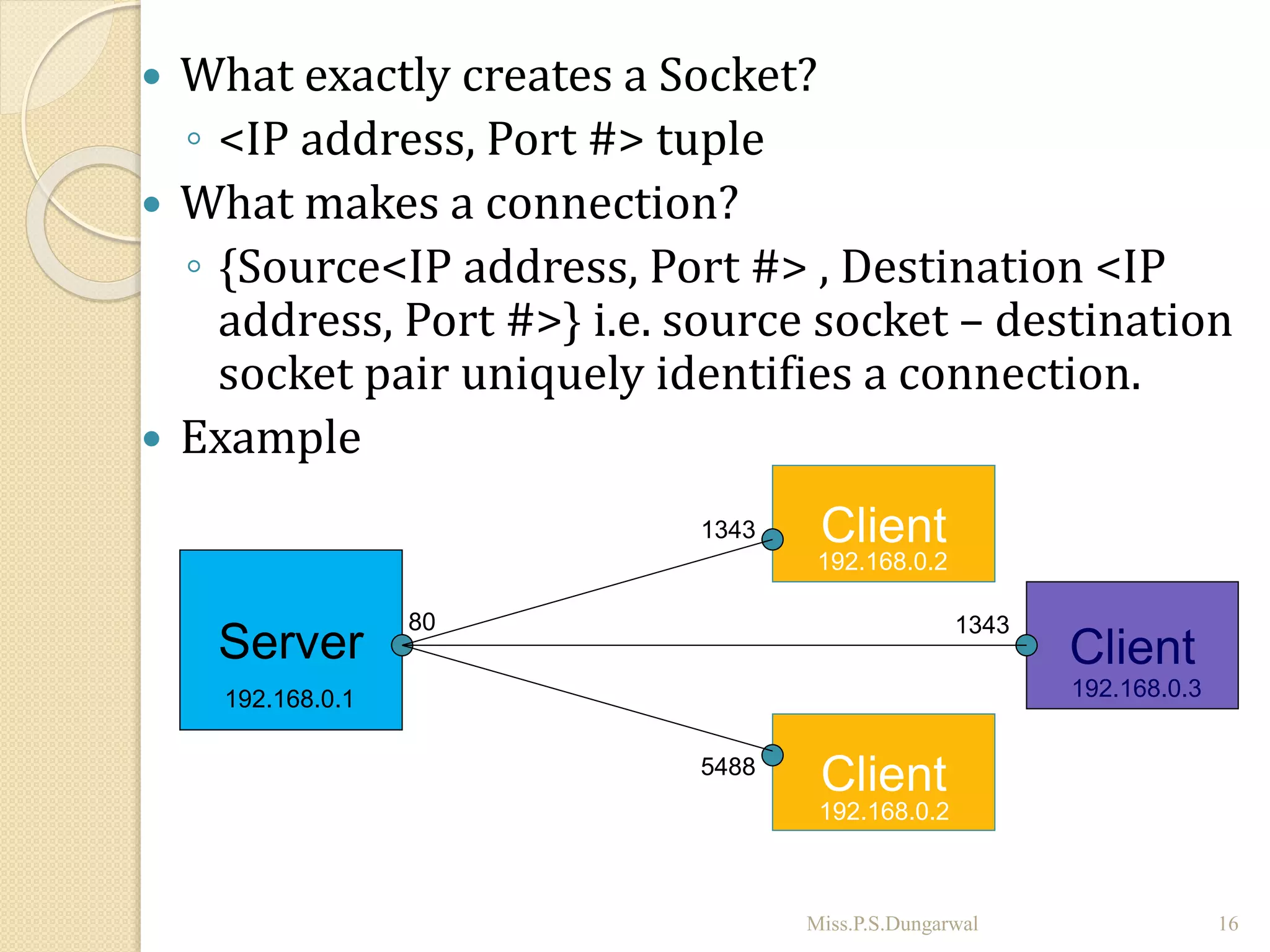
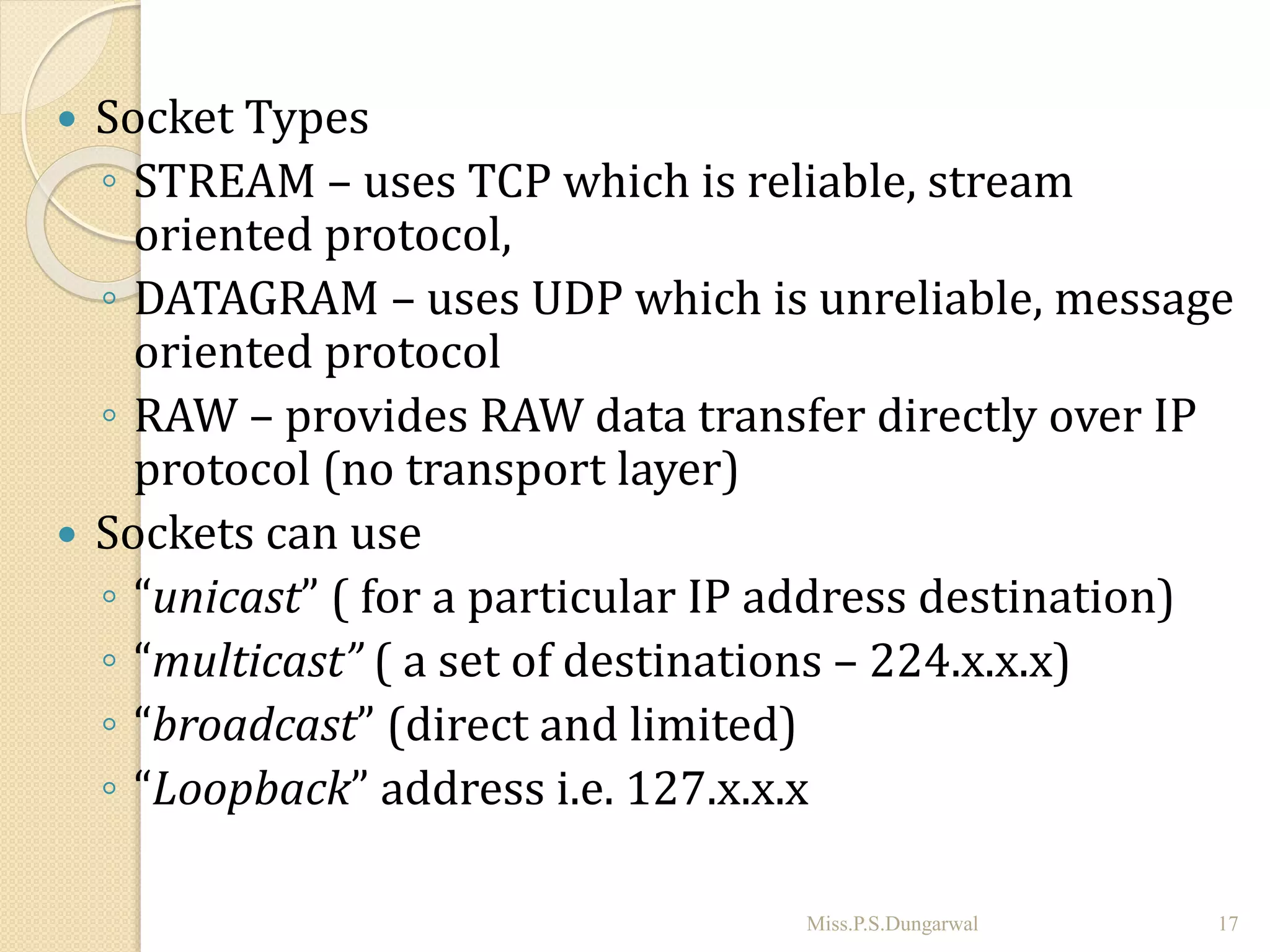
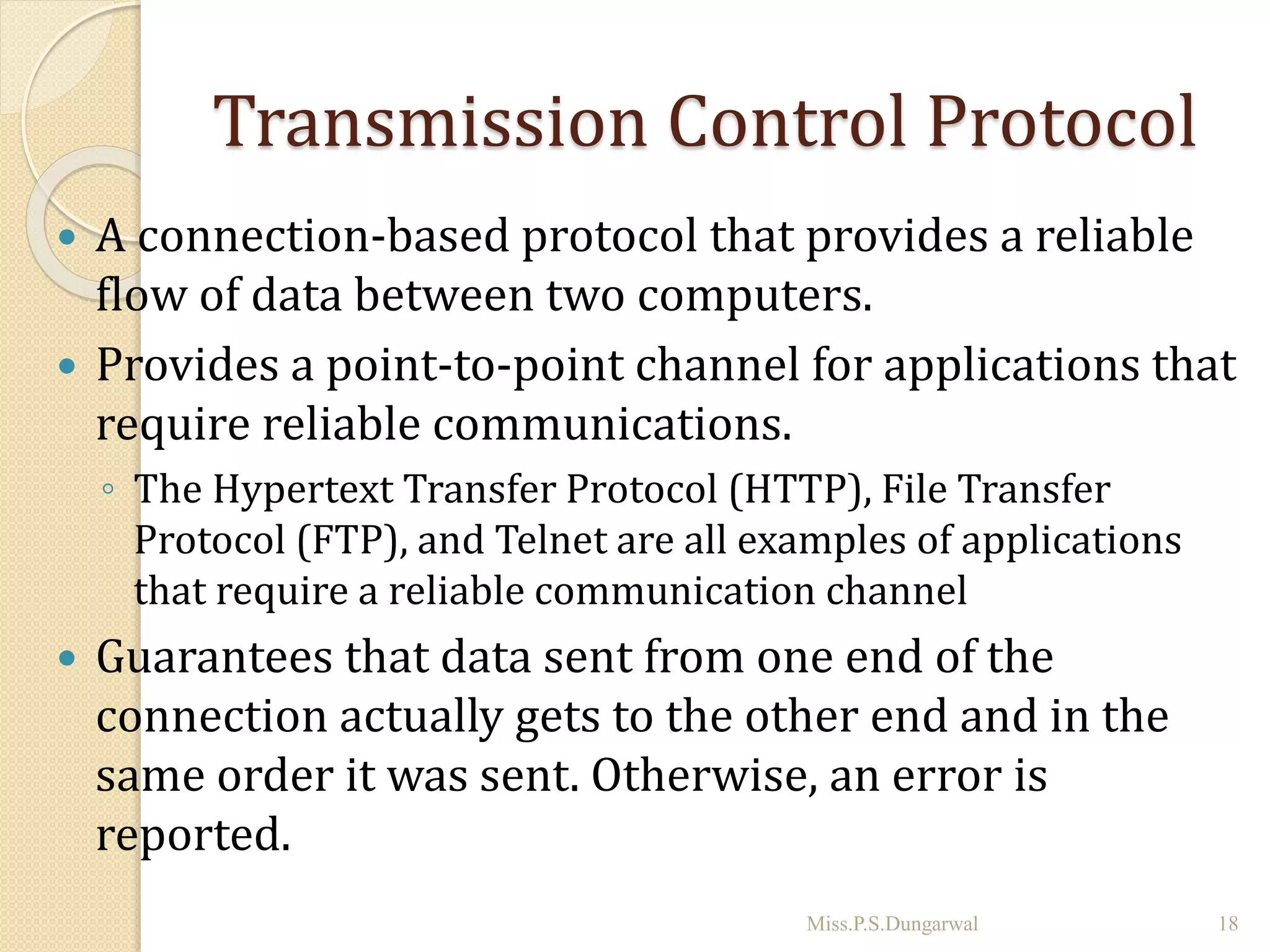
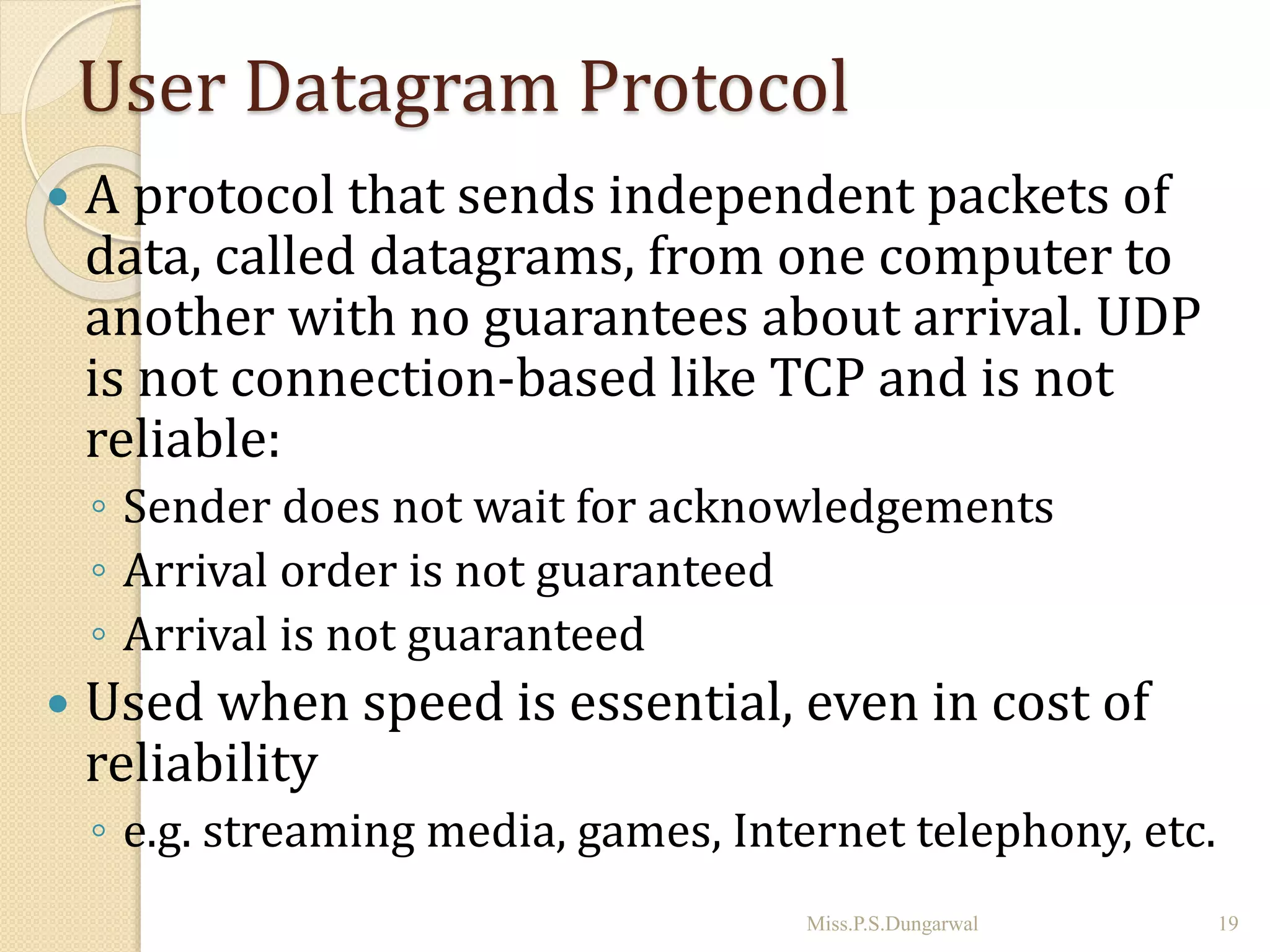
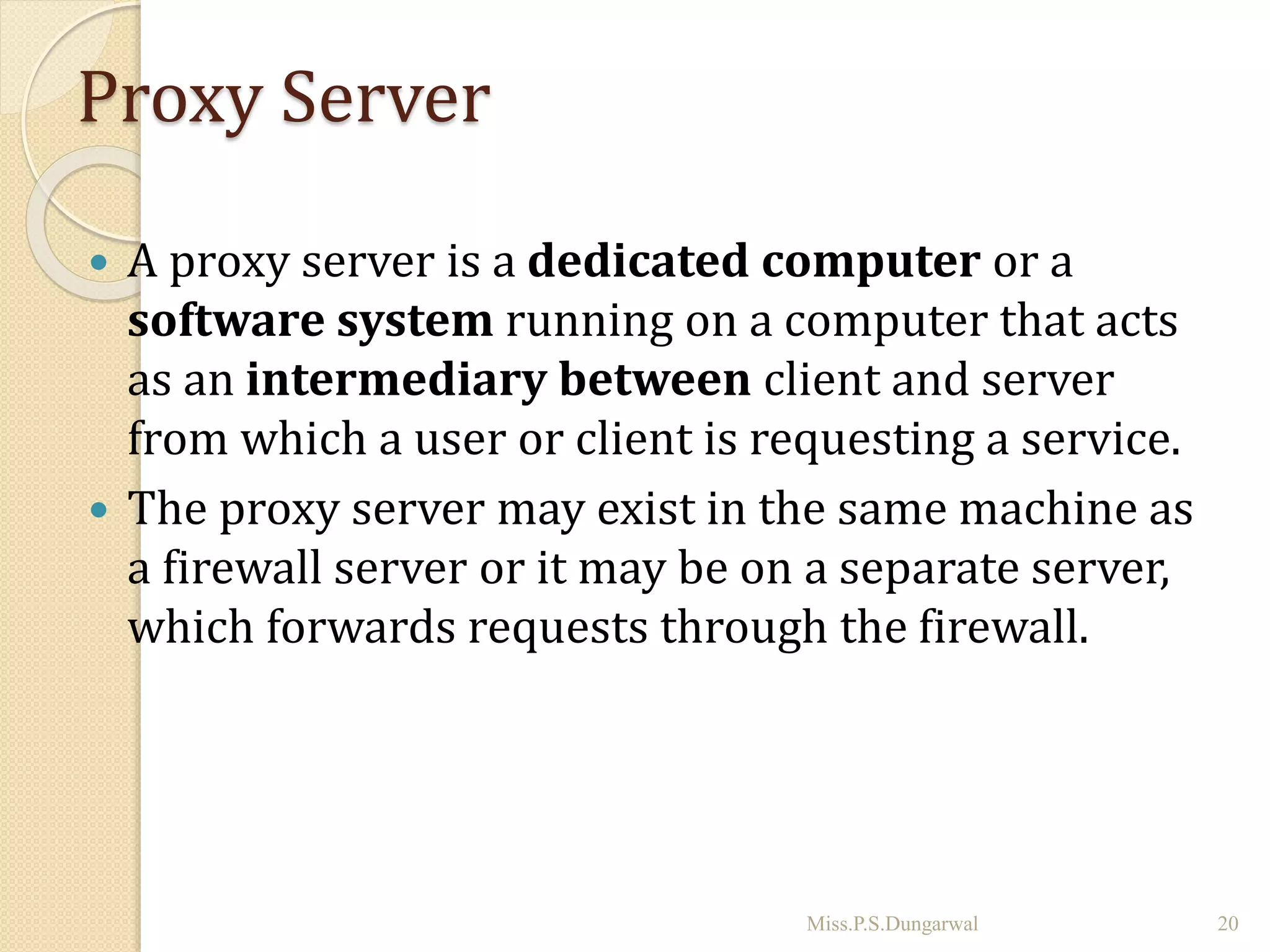
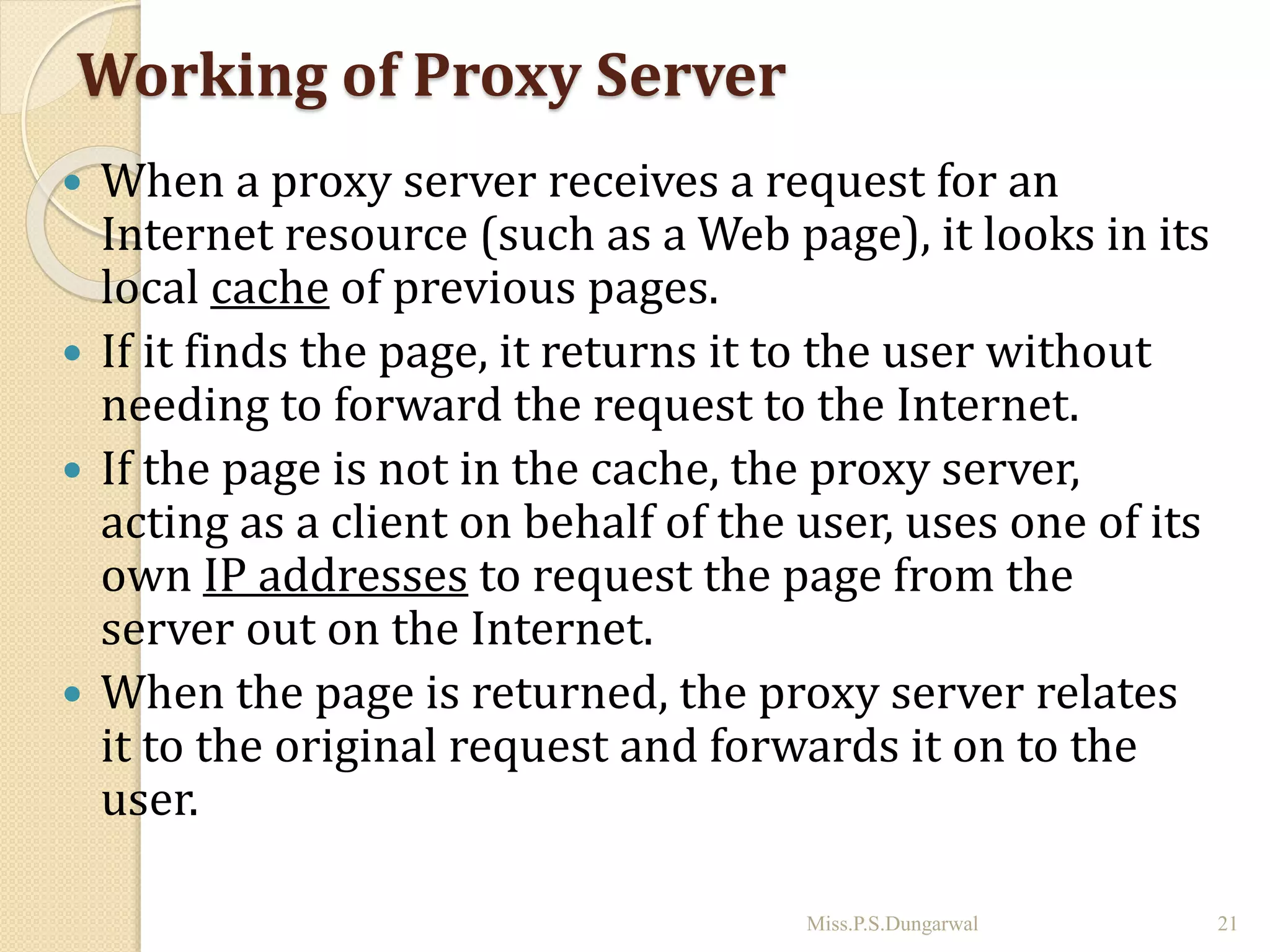
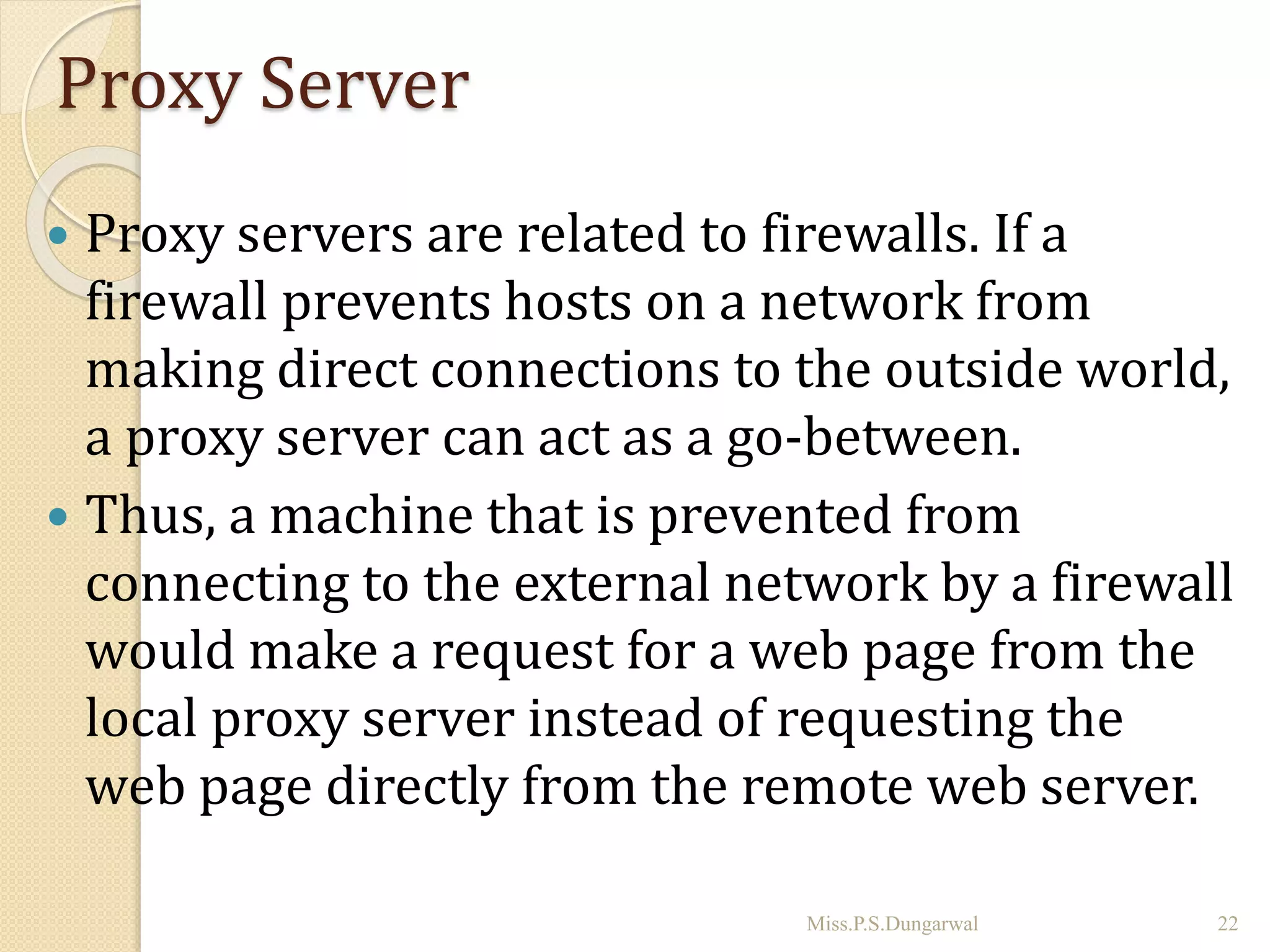
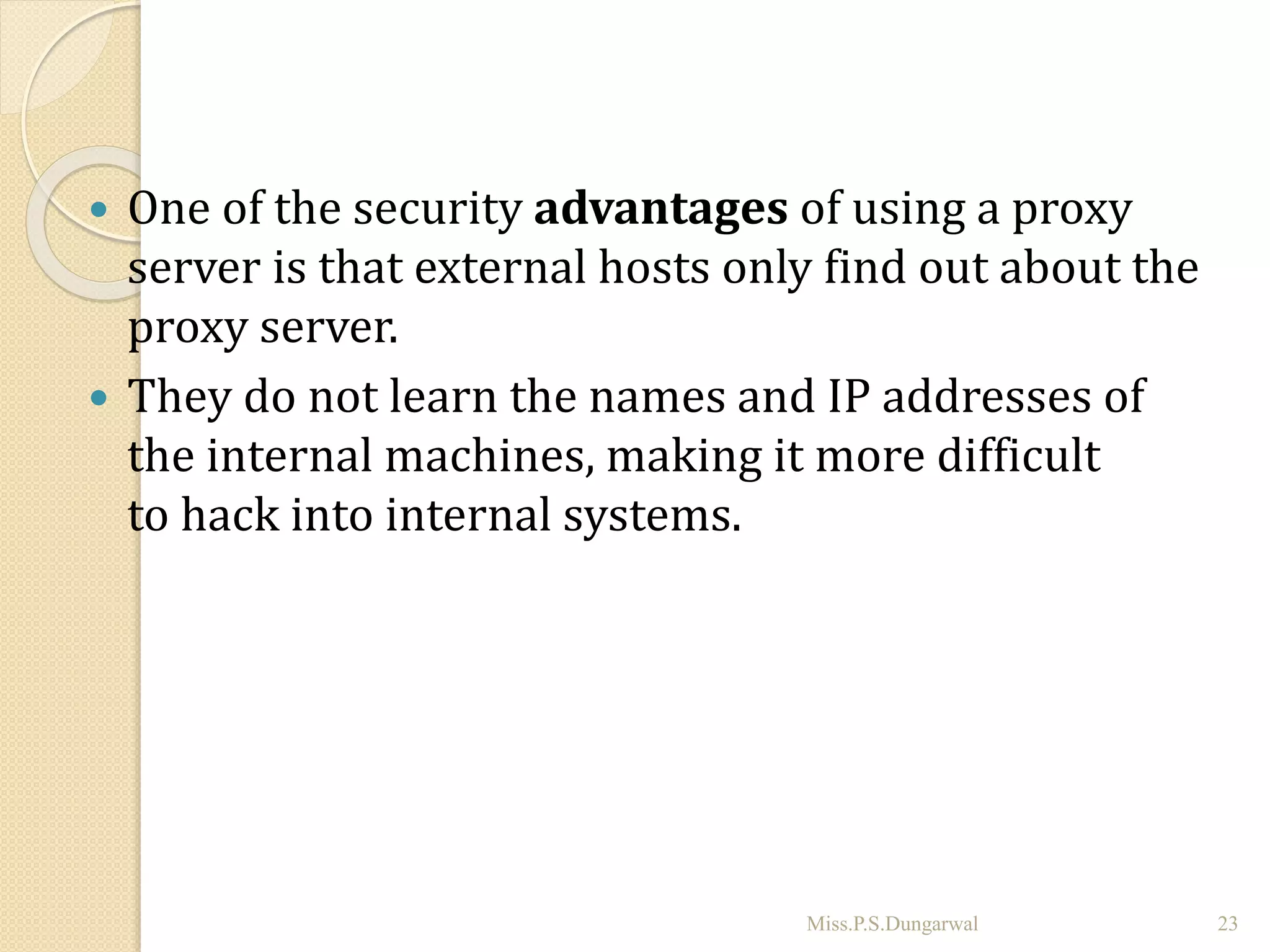
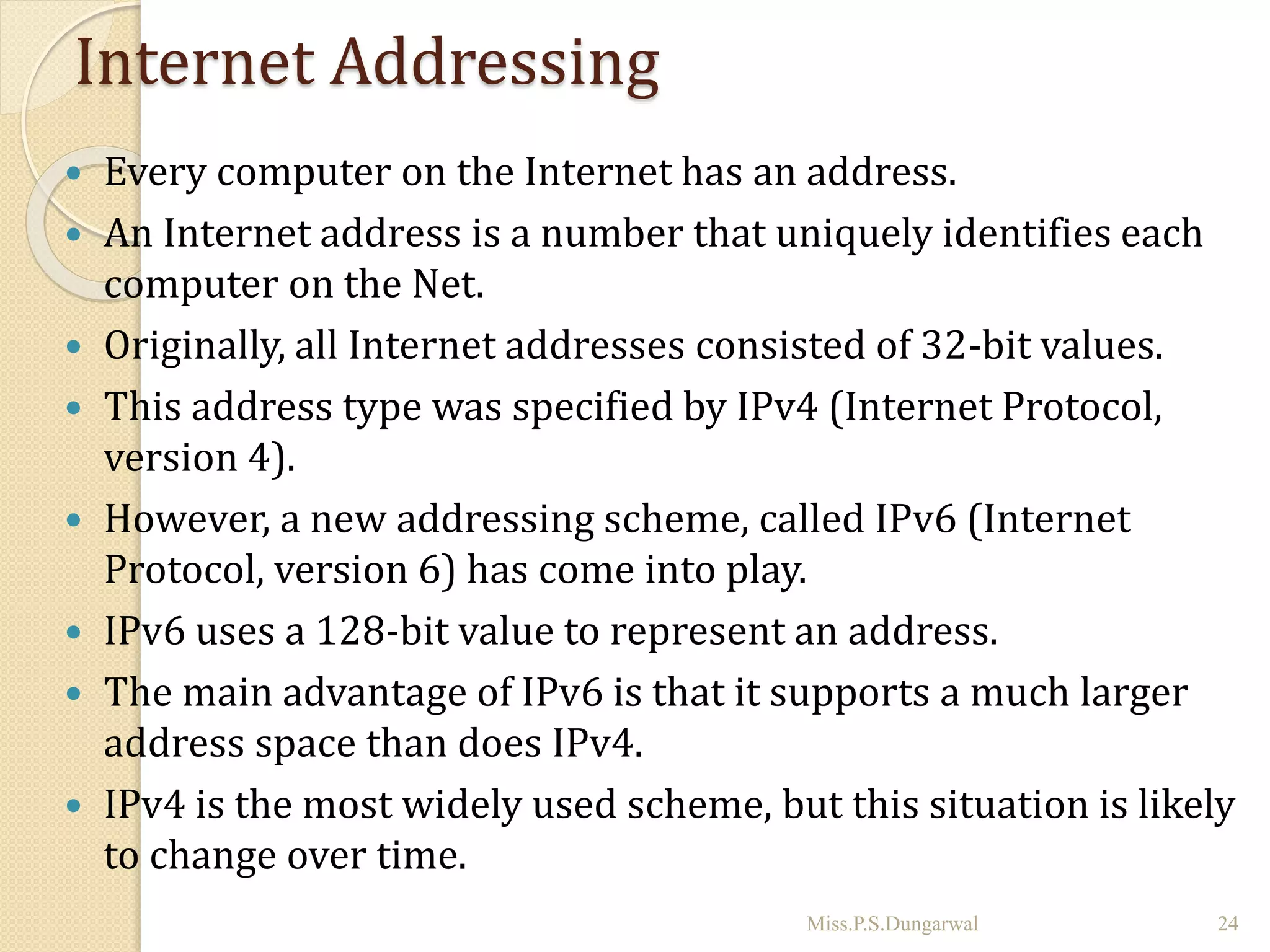
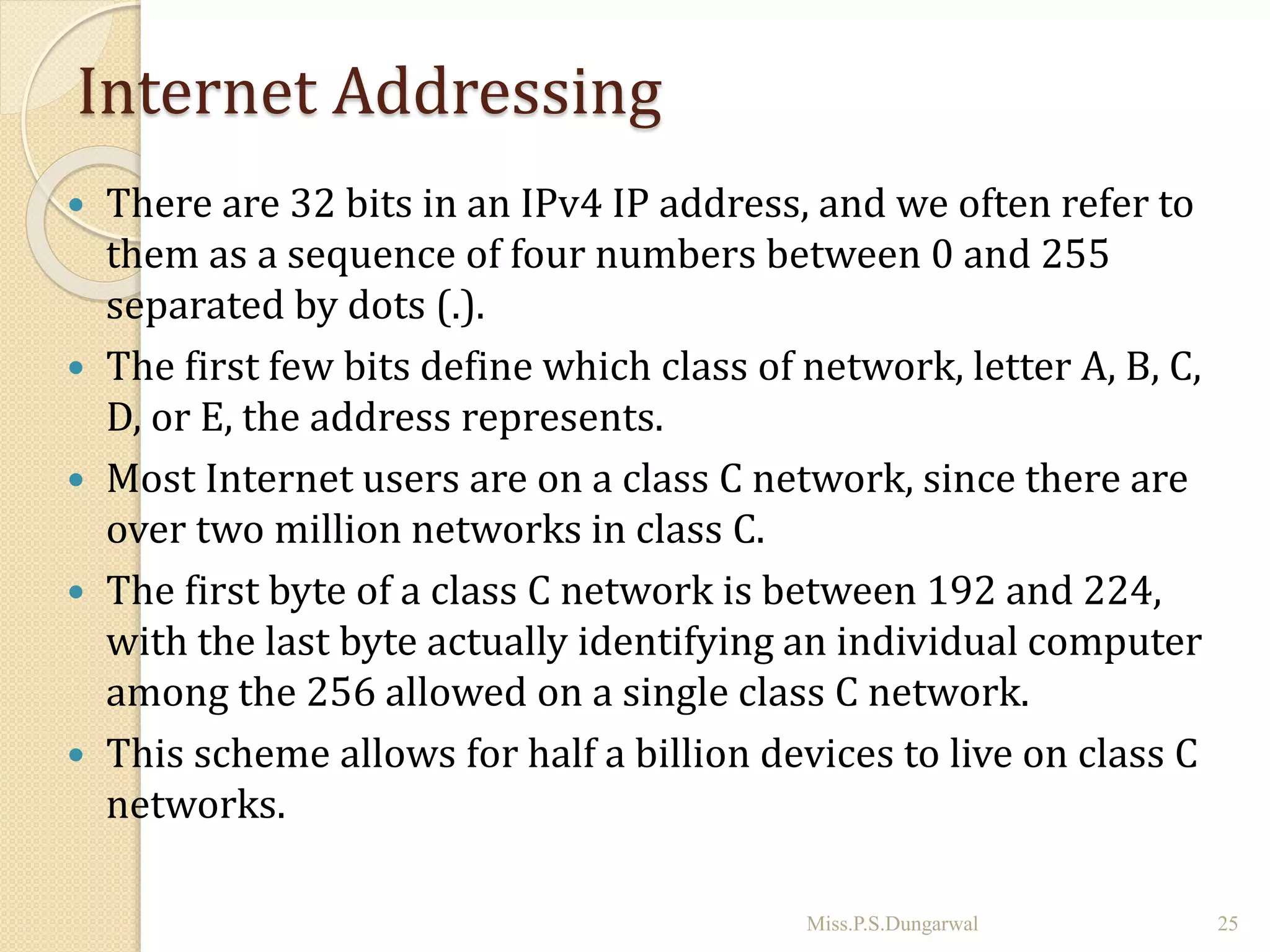
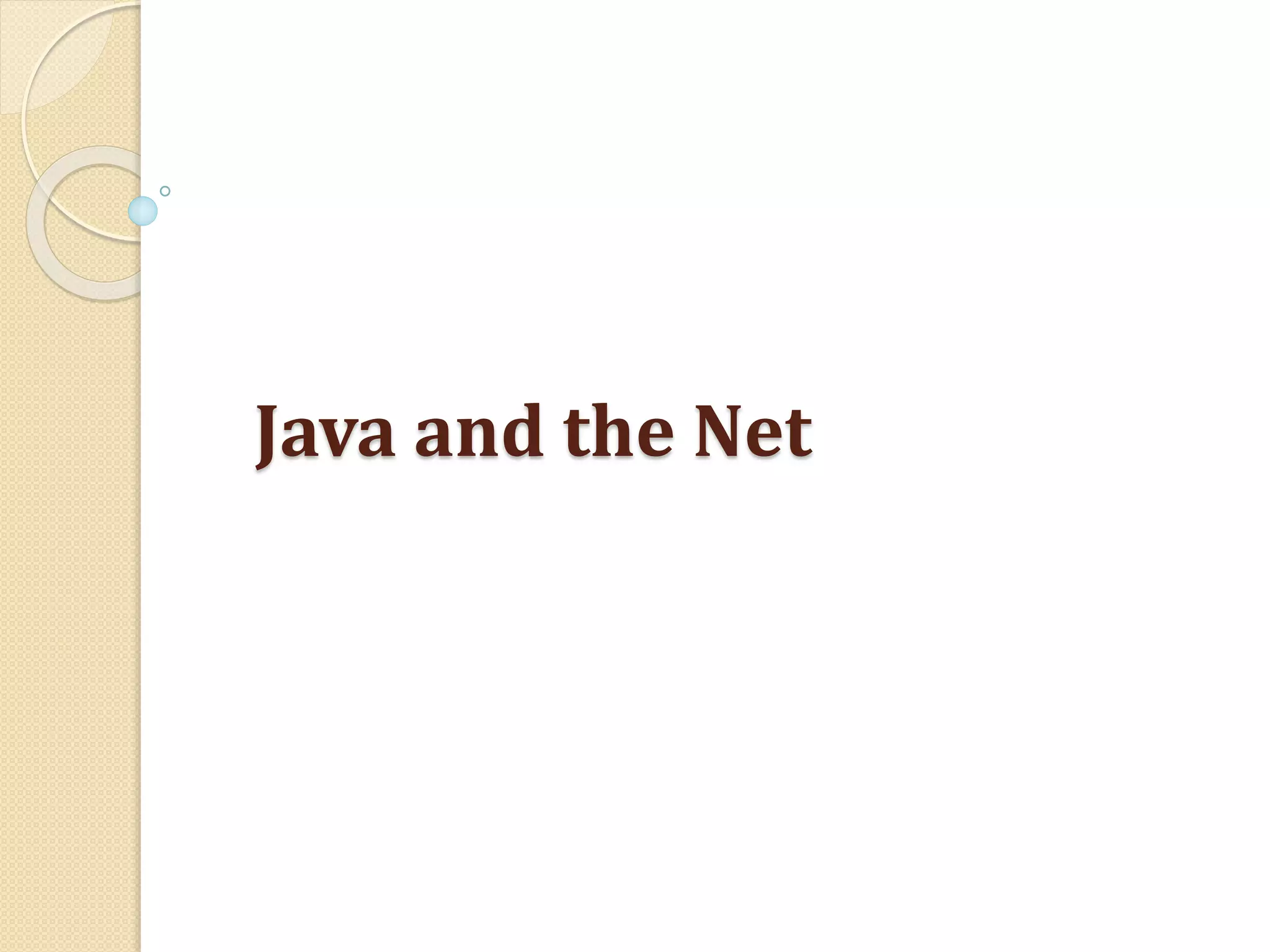
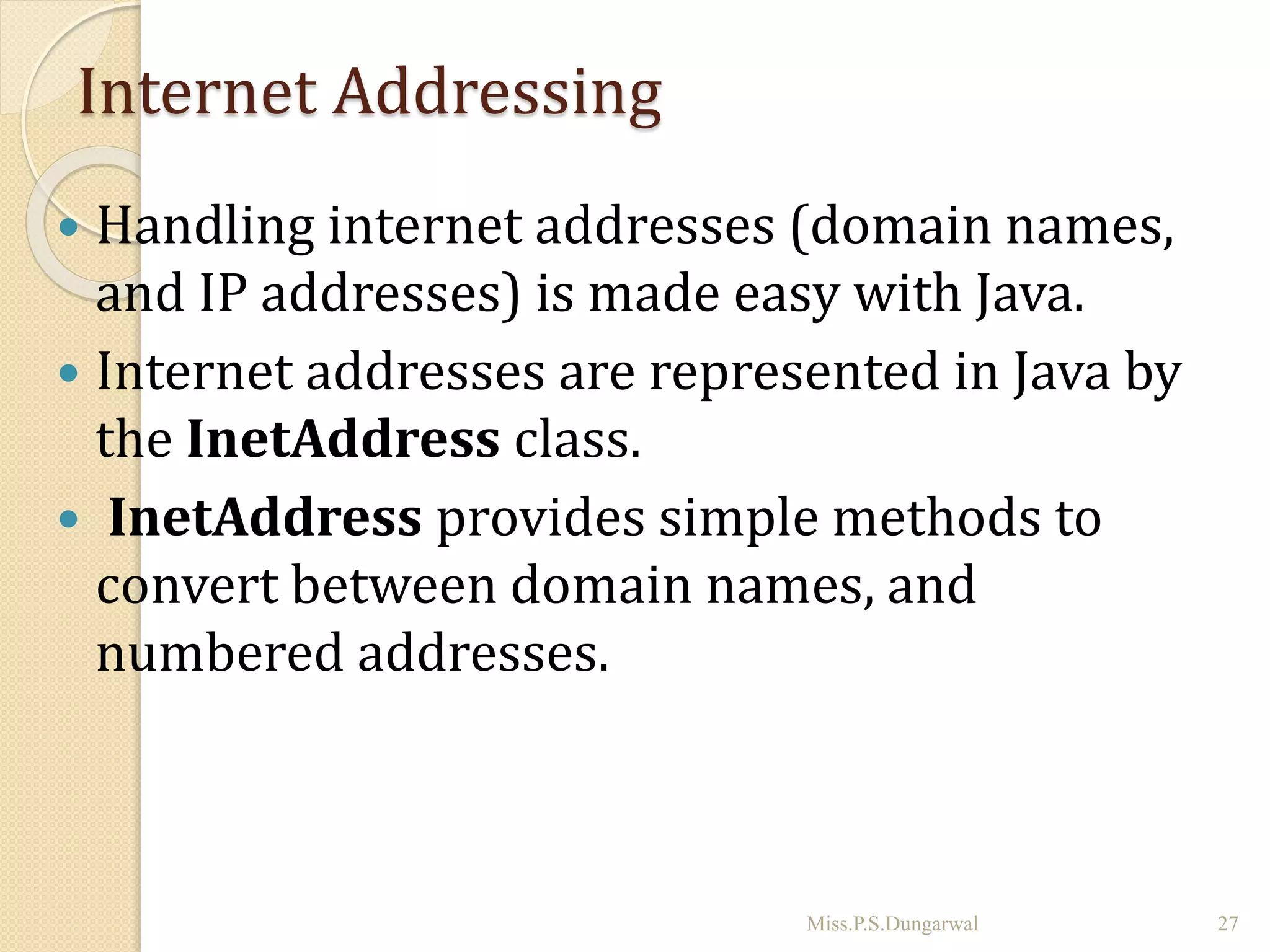
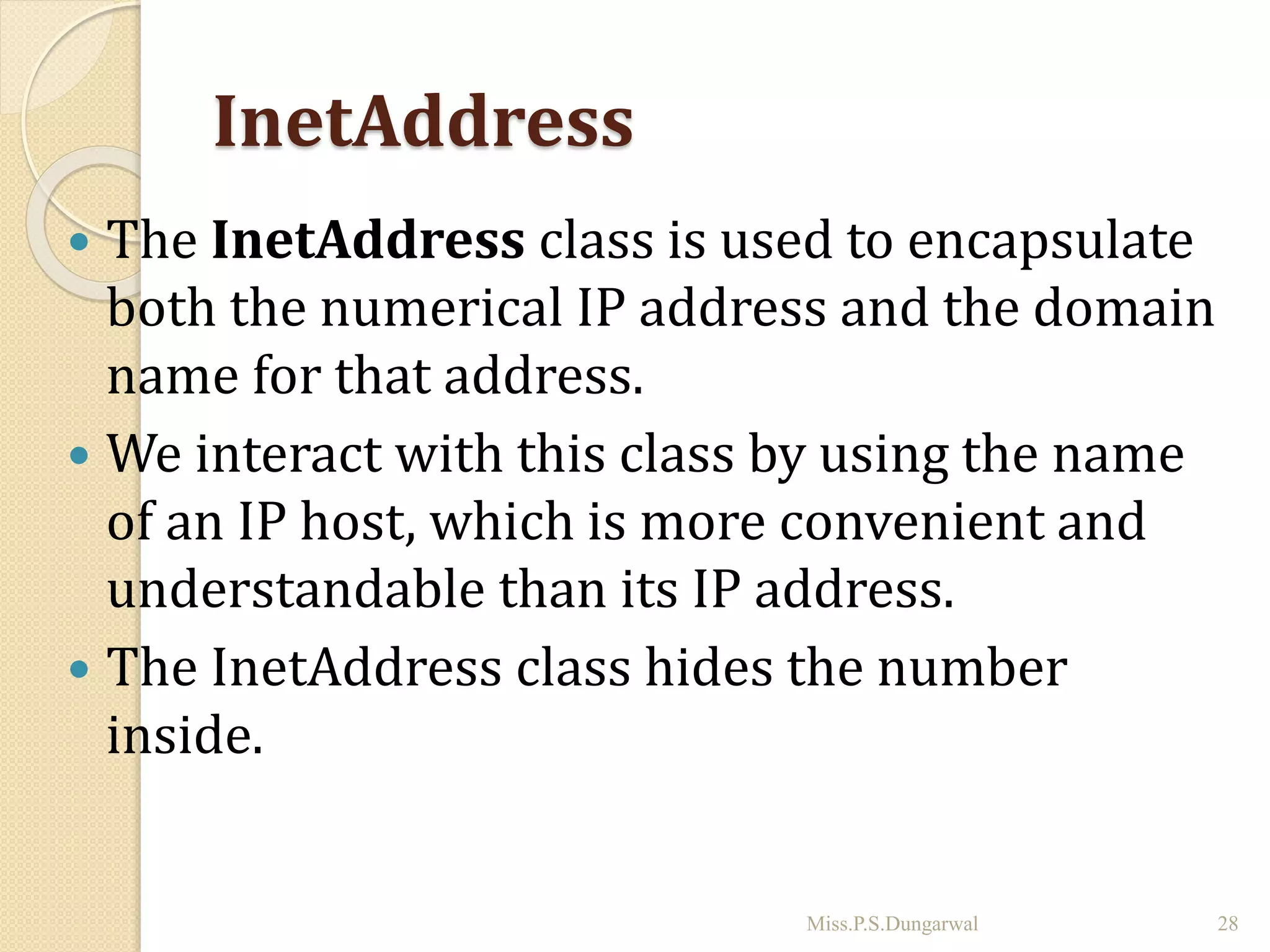
![InetAddress class
• static methods you can use to create new
InetAddress objects.
–getByName(String host)
–getAllByName(String host)
–getLocalHost()
–getByAddress(Byte[] addr)
–getByAddress(String host, Byte[] addr)
InetAddress x = InetAddress.getByName( “msbte.com”);
throws UnknownHostException
29Miss.P.S.Dungarwal](https://image.slidesharecdn.com/chapter-4-networking-200520081049/75/Advance-Java-Programming-CM5I-4-Networking-Basics-29-2048.jpg)
![Factory Methods
static InetAddress getLocalHost( )
• returns the IP address of the localhost machine.
static InetAddress getByName(String hostName)
• returns an InetAddress instance representing the hostname.
static InetAddress[ ] getAllByName(String hostName)
• returns an array of InetAddress instances representing the
hostname.
static InetAddress getByAddress(byte[] addr)
• Returns an InetAddress object given the raw IP address.
static InetAddress getByAddress(String host, byte[]
addr)
• Creates an InetAddress based on the provided host name
and IP address.*Note each methiod: throws UnknownHostException 30Miss.P.S.Dungarwal](https://image.slidesharecdn.com/chapter-4-networking-200520081049/75/Advance-Java-Programming-CM5I-4-Networking-Basics-30-2048.jpg)
![Factory Methods Example
class InetAddressTest {
public static void main(String args[])
throws UnknownHostException {
InetAddress Address =
InetAddress.getLocalHost();
System.out.println(Address);
Address =
InetAddress.getByName("www.javatpont.com");
System.out.println(Address);
InetAddress
SW[]=InetAddress.getAllByName("www.yahoo.com");
for (int i=0; i<SW.length; i++)
System.out.println(SW[i]); }}
D:jdk1.7.0_17bin>java InetAddressTes
DESKTOP-OJIM16I/192.168.0.5
google.com/172.217.166.46
www.yahoo.com/106.10.250.11
www.yahoo.com/106.10.250.10
31Miss.P.S.Dungarwal](https://image.slidesharecdn.com/chapter-4-networking-200520081049/75/Advance-Java-Programming-CM5I-4-Networking-Basics-31-2048.jpg)
![Instance Methods
boolean equals(Object obj)
◦ Compares two IP addresses, returns true if there is a match.
byte[ ] getAddress( )
◦ Returns the IP address in byte format.
String getHostAddress( )
◦ Returns the IP address in dotted decimal format.
String getHostName( )
◦ Returns the hostname of the InetAddress.
boolean isMulticastAddress( )
◦ Returns true if the InetAddress is a multicast address (class
D address).
• String toString()
◦ Converts this IP address to a String.
32Miss.P.S.Dungarwal](https://image.slidesharecdn.com/chapter-4-networking-200520081049/75/Advance-Java-Programming-CM5I-4-Networking-Basics-32-2048.jpg)
![Instance Methods
import java.net.*;
class InetAddressTest1{
public static void main(String args[])throws
UnknownHostException {
InetAddress Address =
InetAddress.getByName("www.google.com");
System.out.println(Address.getHostAddress());
System.out.println(Address.getHostName());
if(Address.isMulticastAddress())
System.out.println("It is multicast address");
} }
D:jdk1.7.0_17bin>javac InetAddressTest1.java
D:jdk1.7.0_17bin>java InetAddressTest1
216.58.203.164
www.google.com
33Miss.P.S.Dungarwal](https://image.slidesharecdn.com/chapter-4-networking-200520081049/75/Advance-Java-Programming-CM5I-4-Networking-Basics-33-2048.jpg)
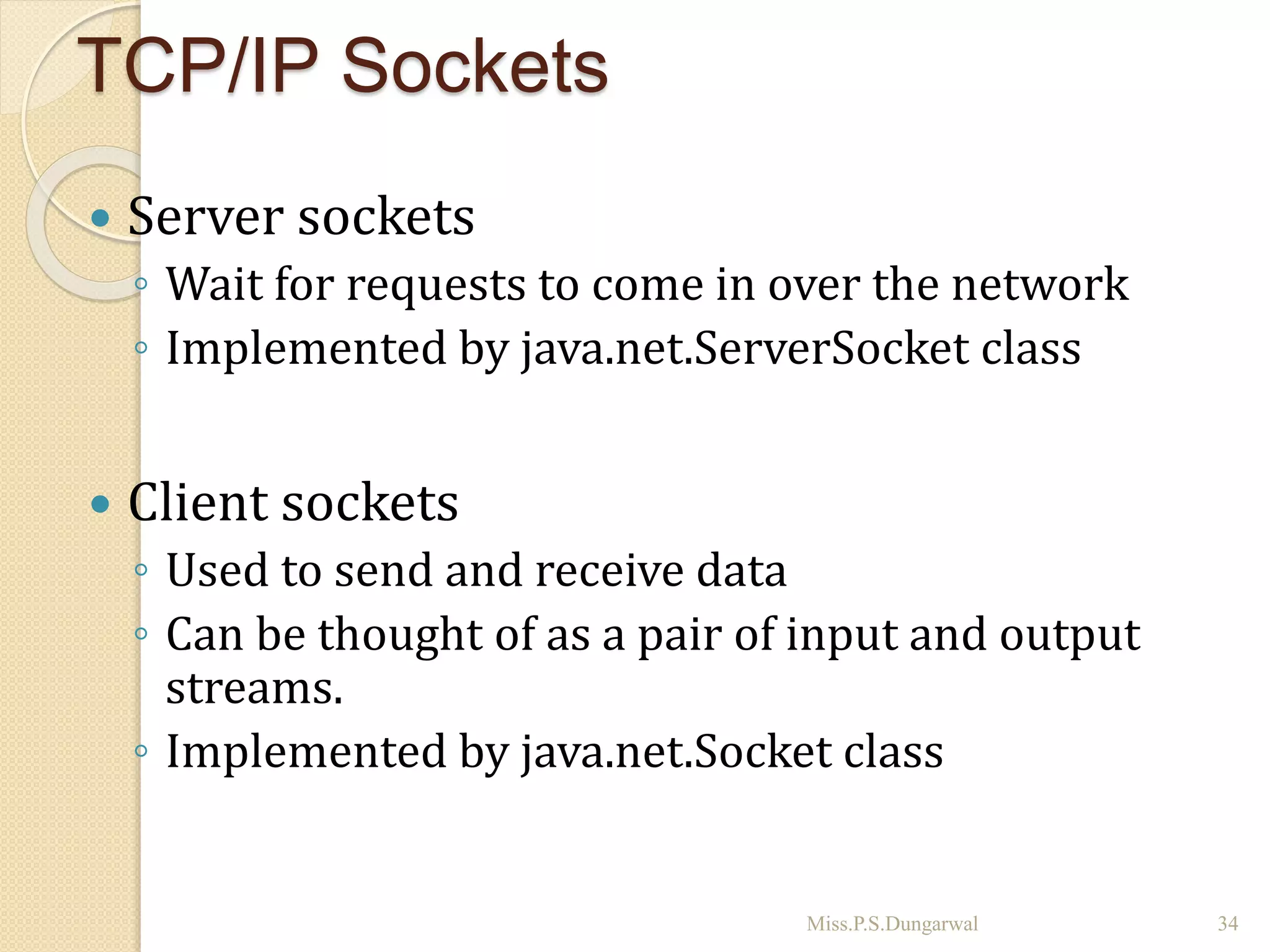
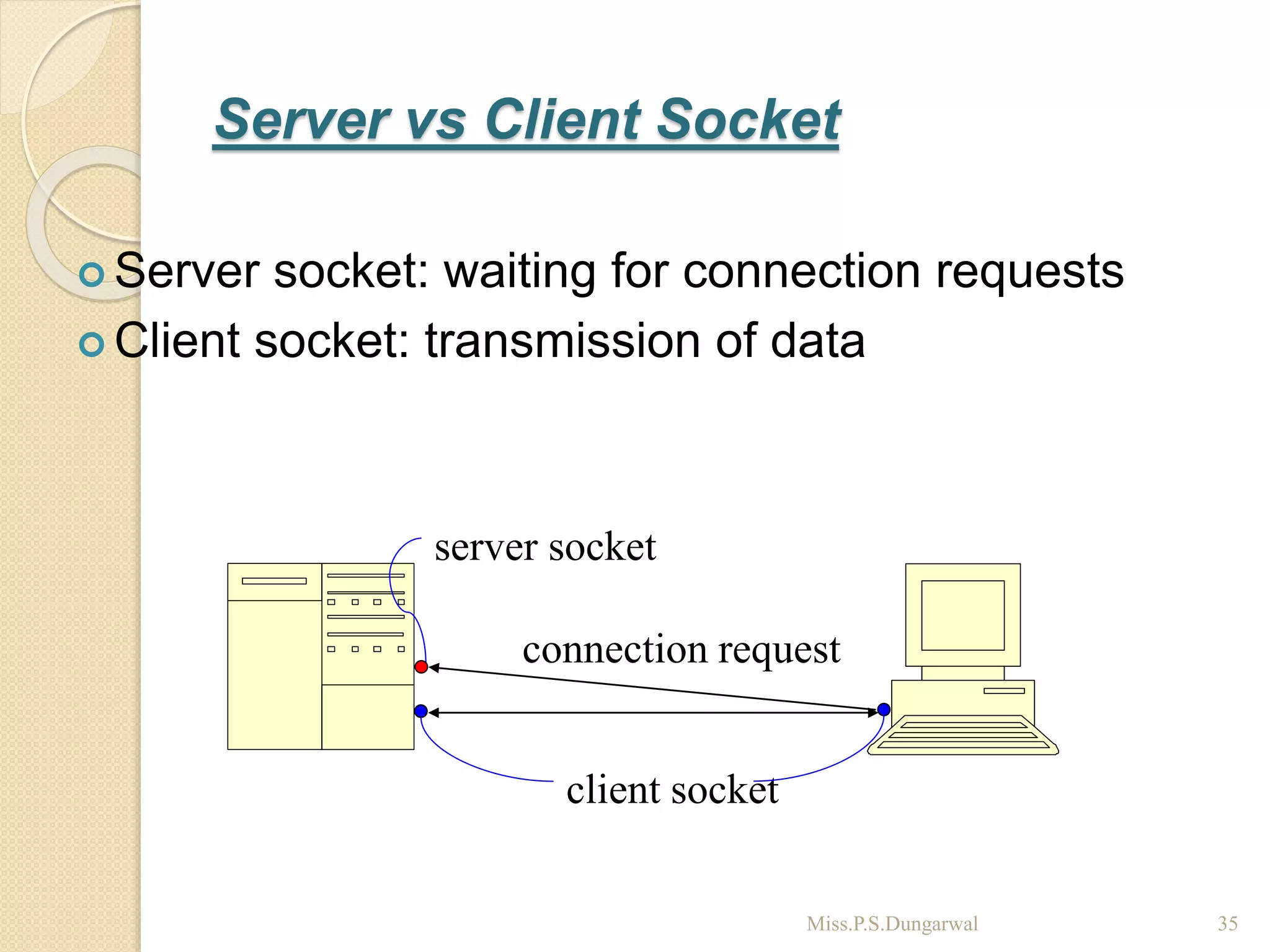
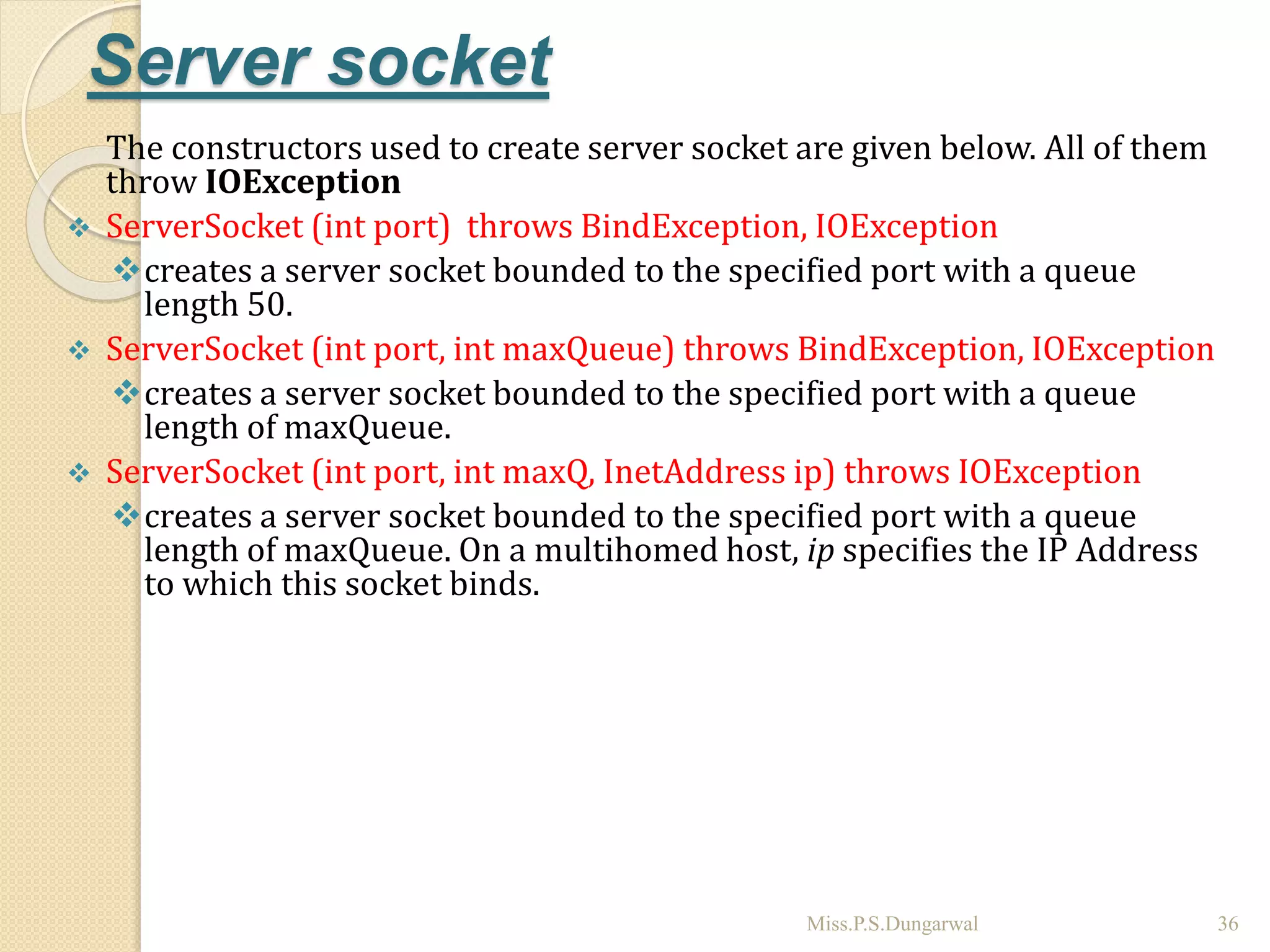
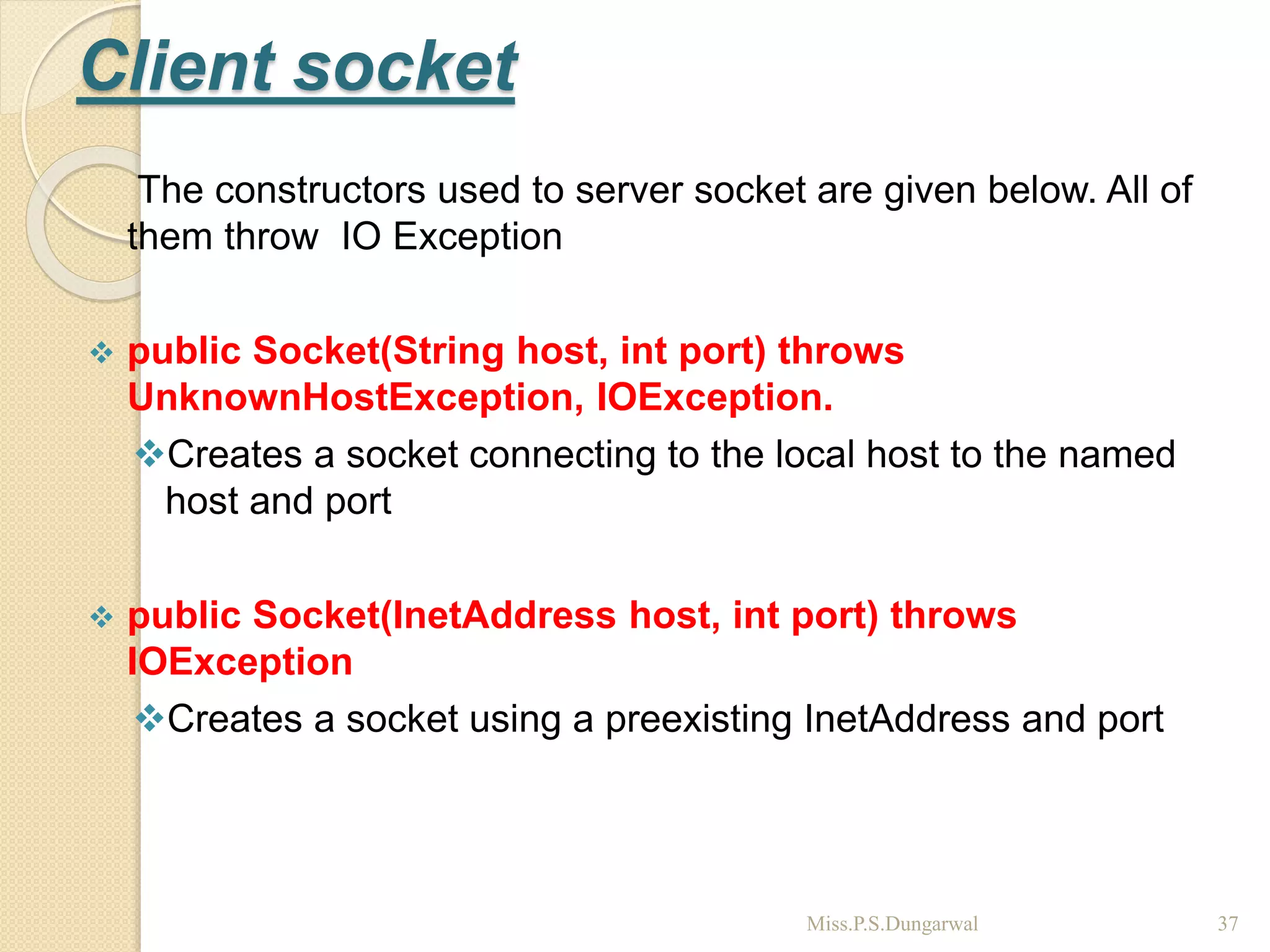
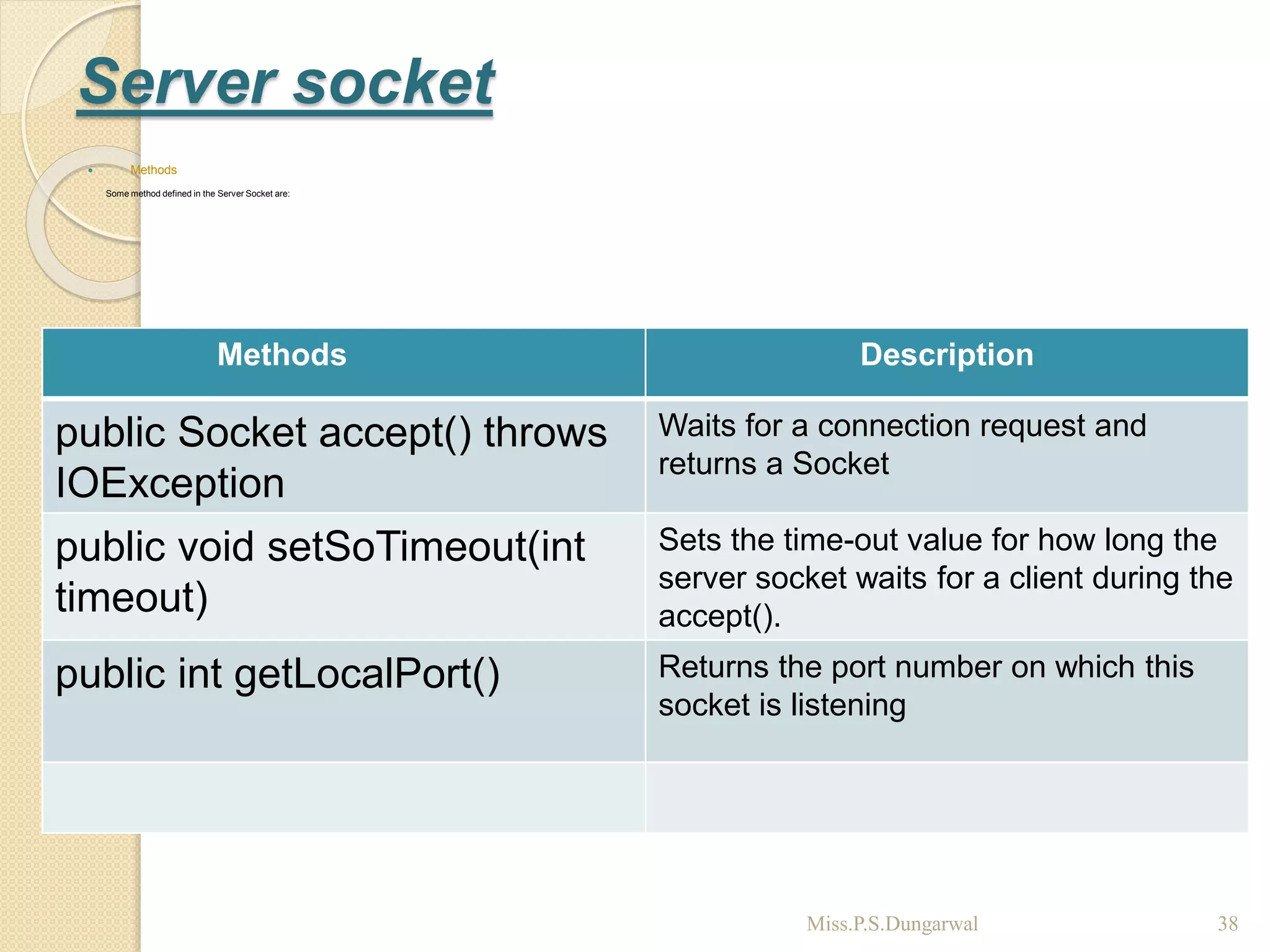
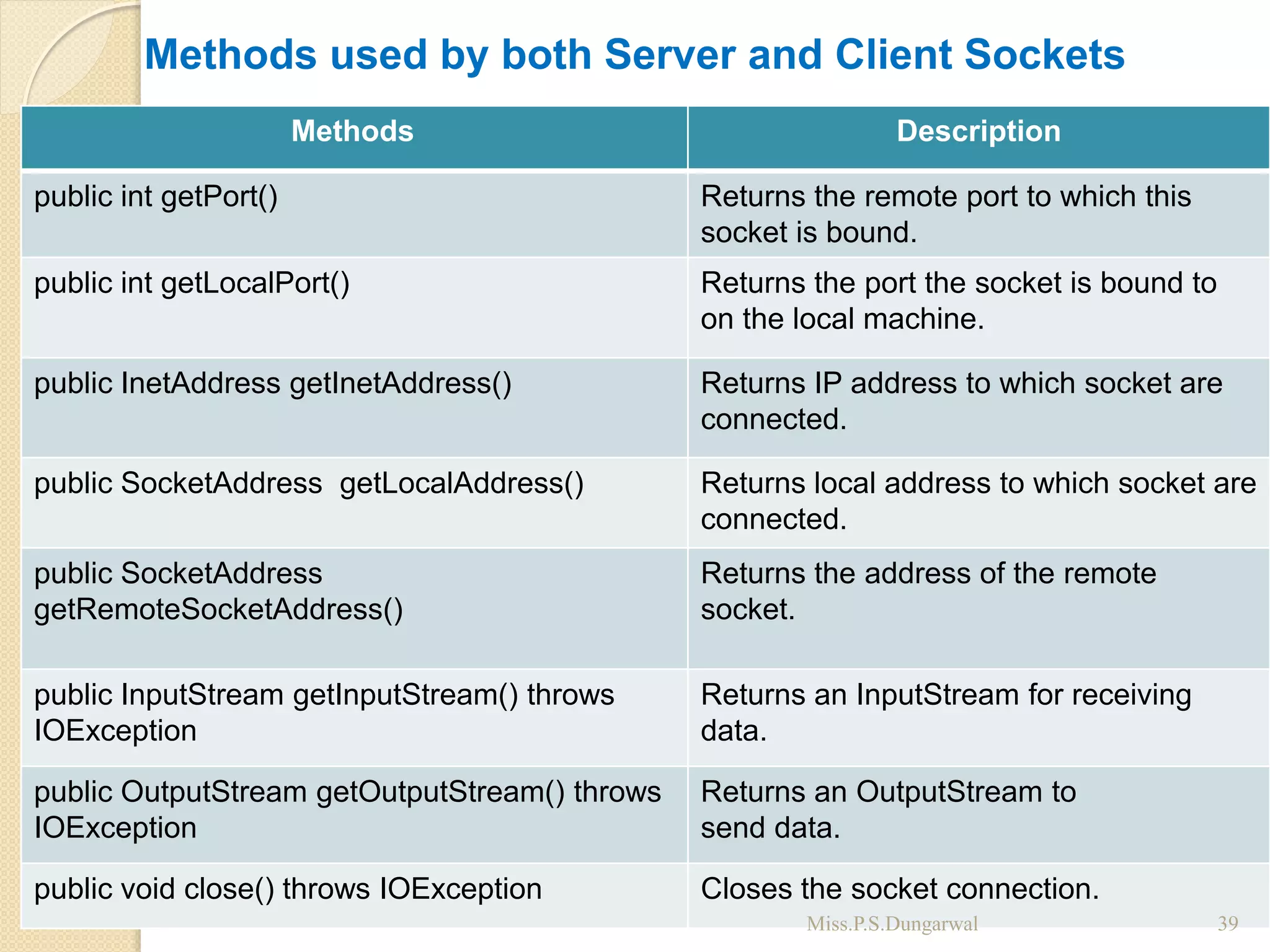
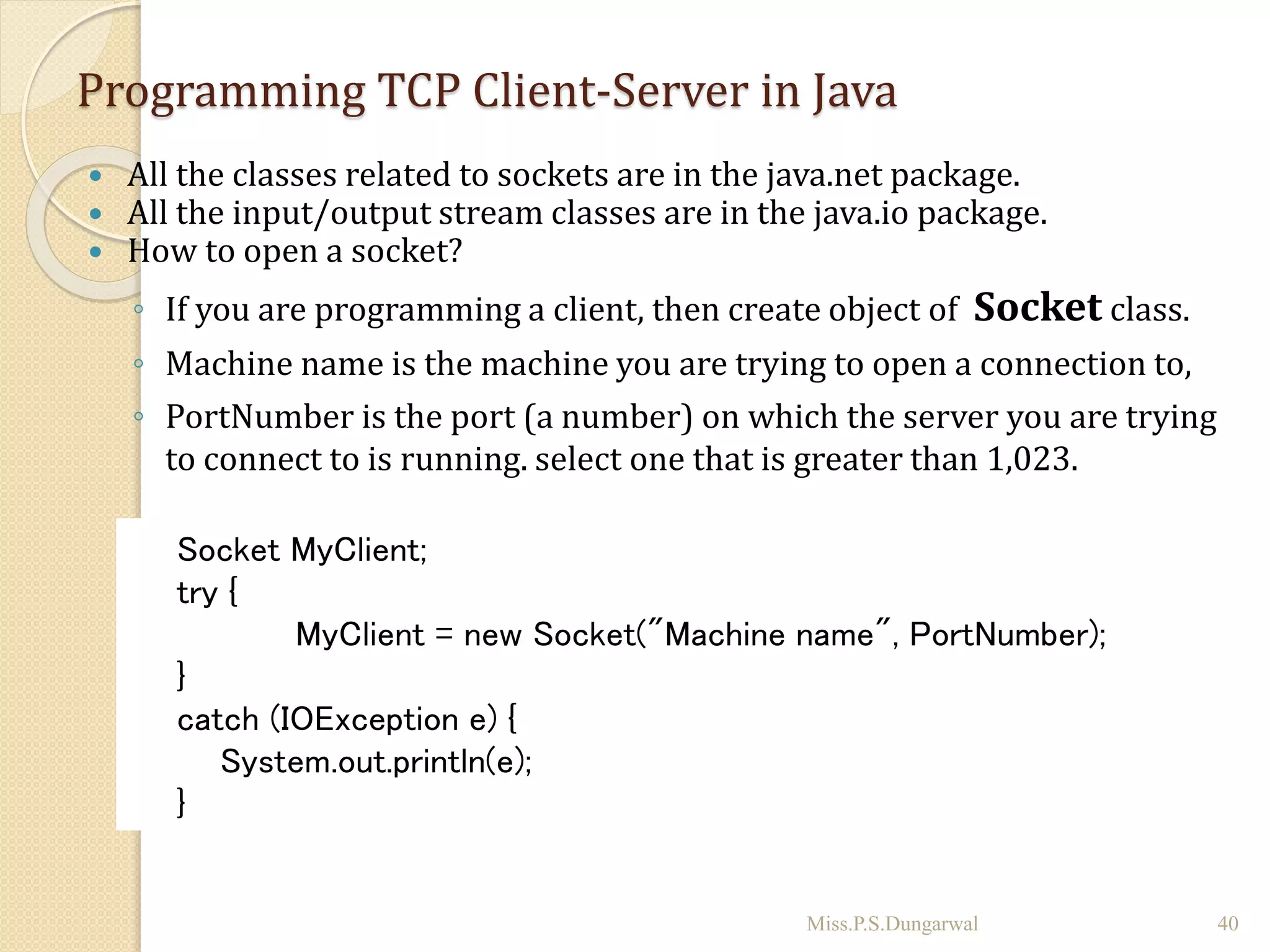
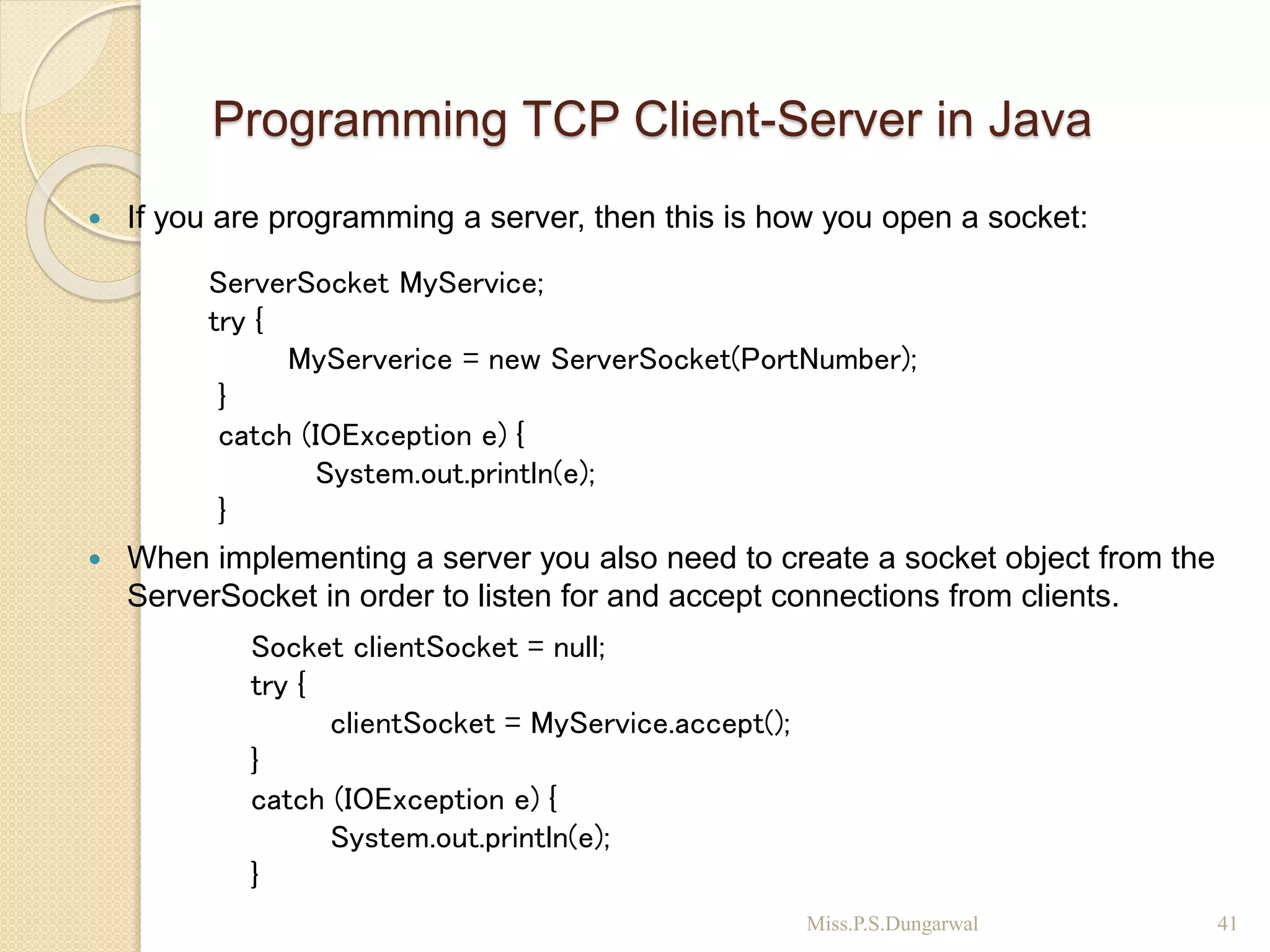
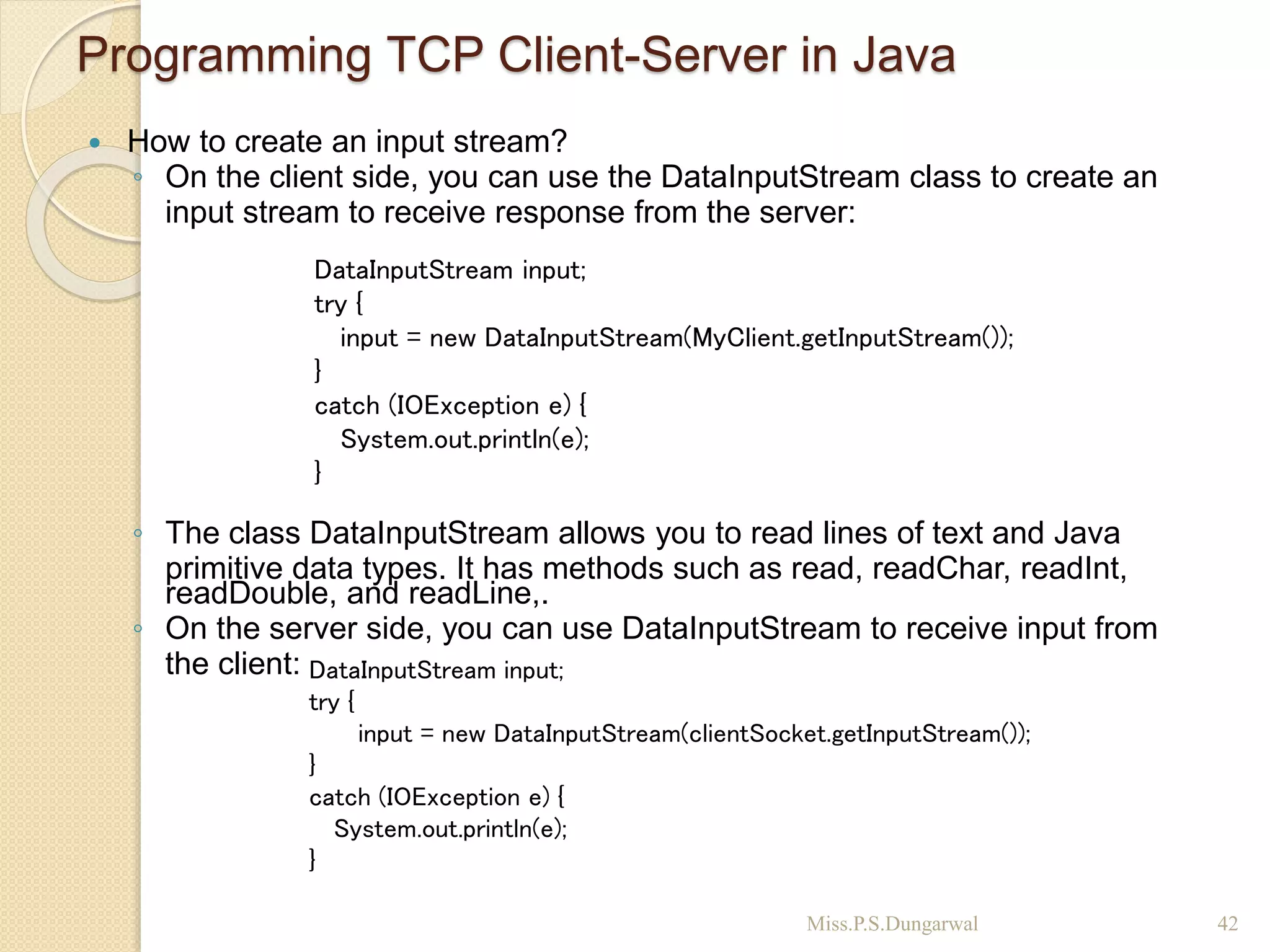
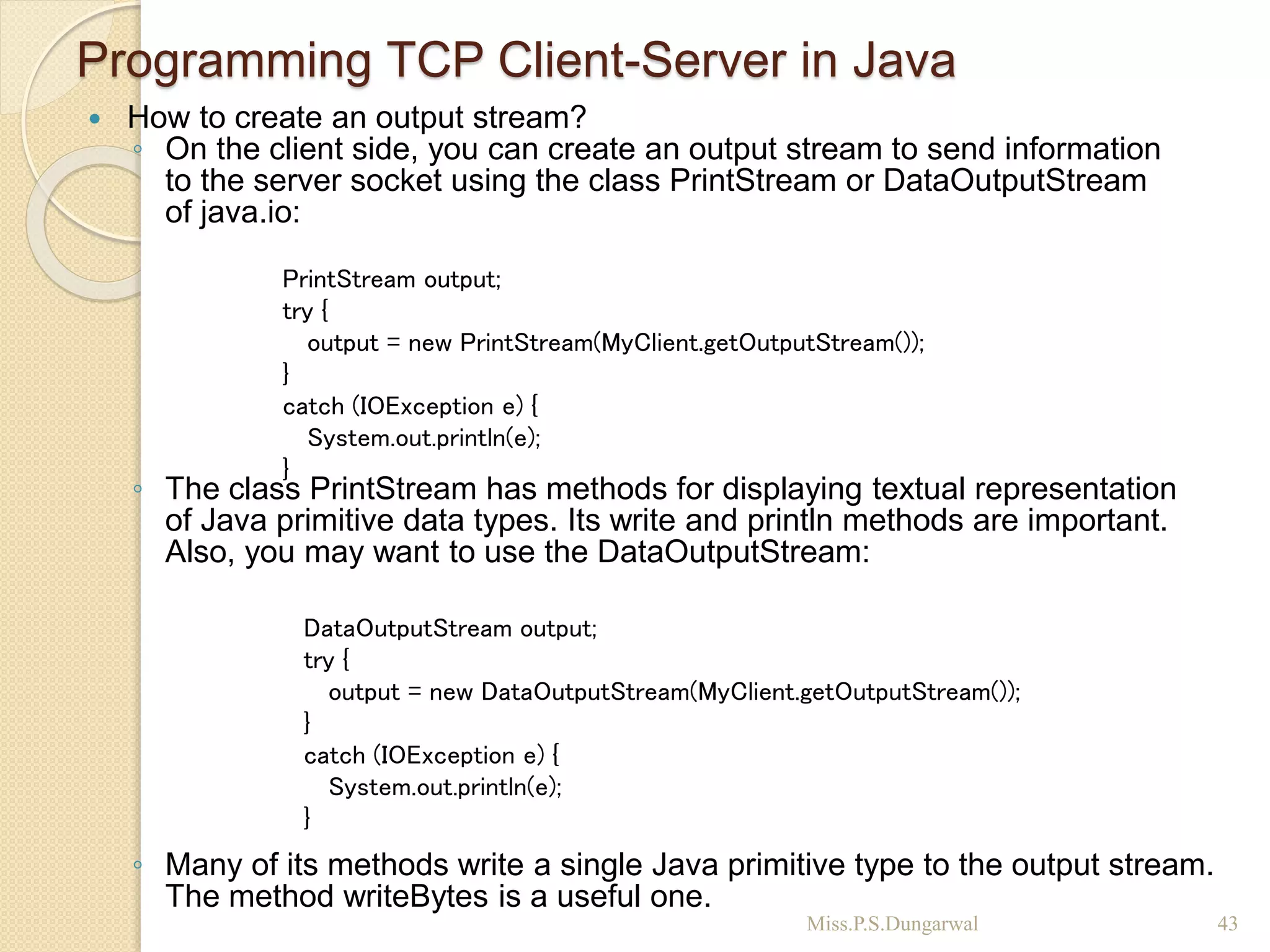
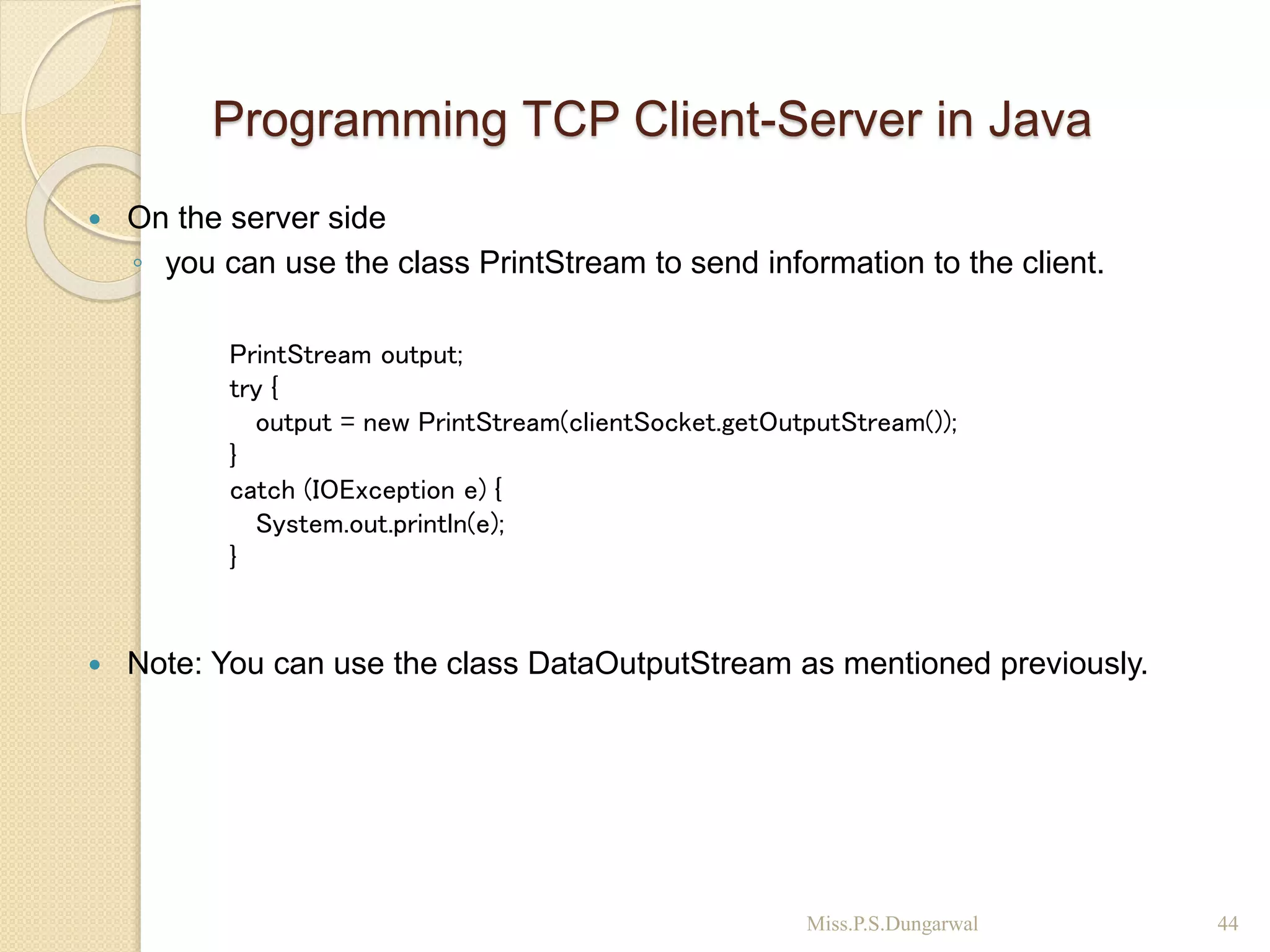
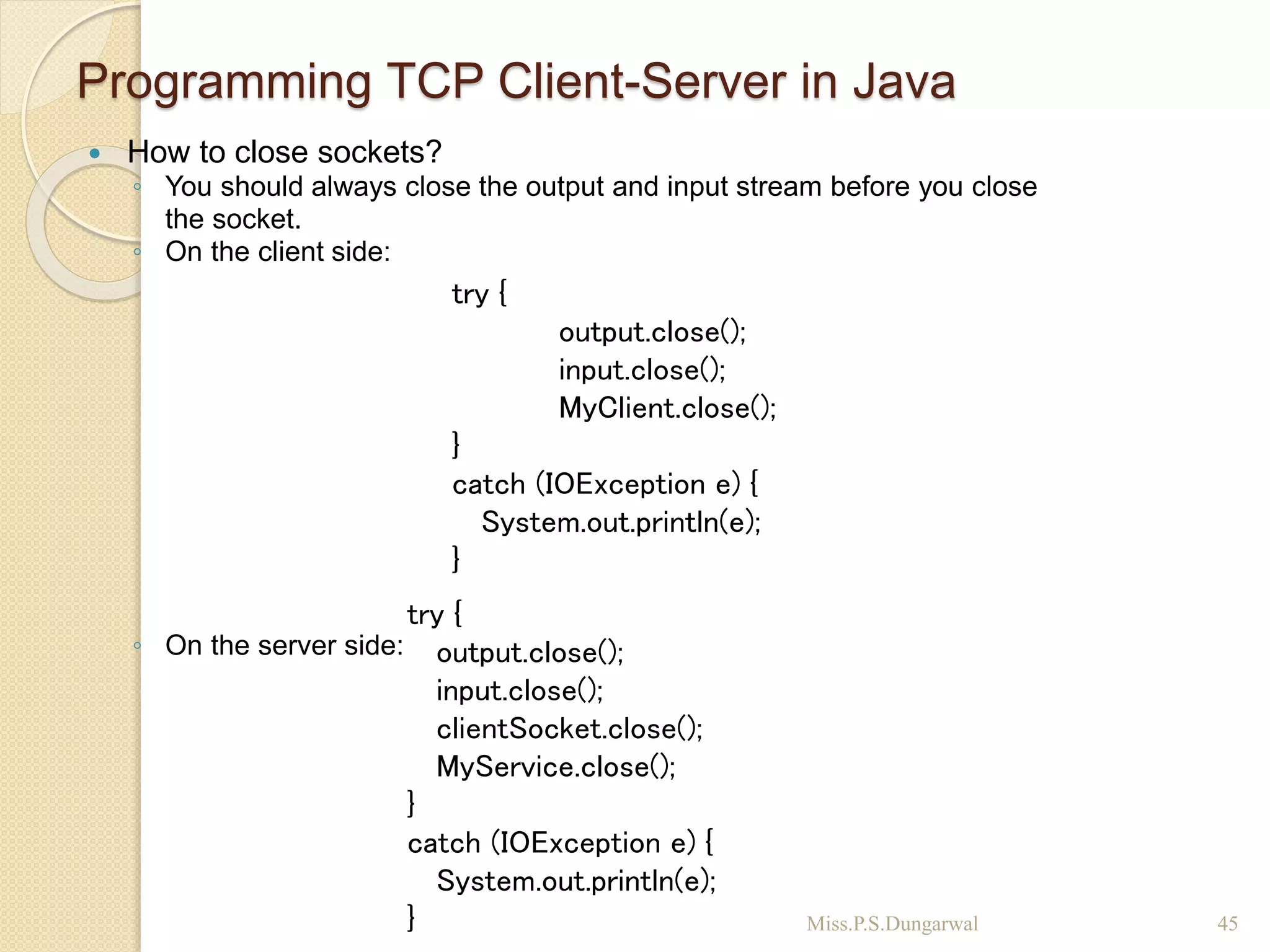
![import java.io.*;
import java.net.*;
public class MyServer
{
public static void main(String[] args)
{
try
{
ServerSocket ss=new ServerSocket(6666);
Socket s=ss.accept();//establishes connection
DataInputStream dis=new DataInputStream(s.getInputStream());
String str=(String)dis.readUTF();
System.out.println("message= "+str);
ss.close();
}
catch(Exception e)
{
System.out.println(e);
}
}
}
File: MyServer.java
46Miss.P.S.Dungarwal](https://image.slidesharecdn.com/chapter-4-networking-200520081049/75/Advance-Java-Programming-CM5I-4-Networking-Basics-46-2048.jpg)
![import java.io.*;
import java.net.*;
public class MyClient
{
public static void main(String[] args)
{
try
{
Socket s=new Socket("localhost",6666);
DataOutputStream dout=new DataOutputStream(s.getOutputStream())
;
dout.writeUTF("Hello Server");
dout.flush();
dout.close();
s.close();
}
catch(Exception e)
{
System.out.println(e);
}
}
MyClient.java
47Miss.P.S.Dungarwal](https://image.slidesharecdn.com/chapter-4-networking-200520081049/75/Advance-Java-Programming-CM5I-4-Networking-Basics-47-2048.jpg)
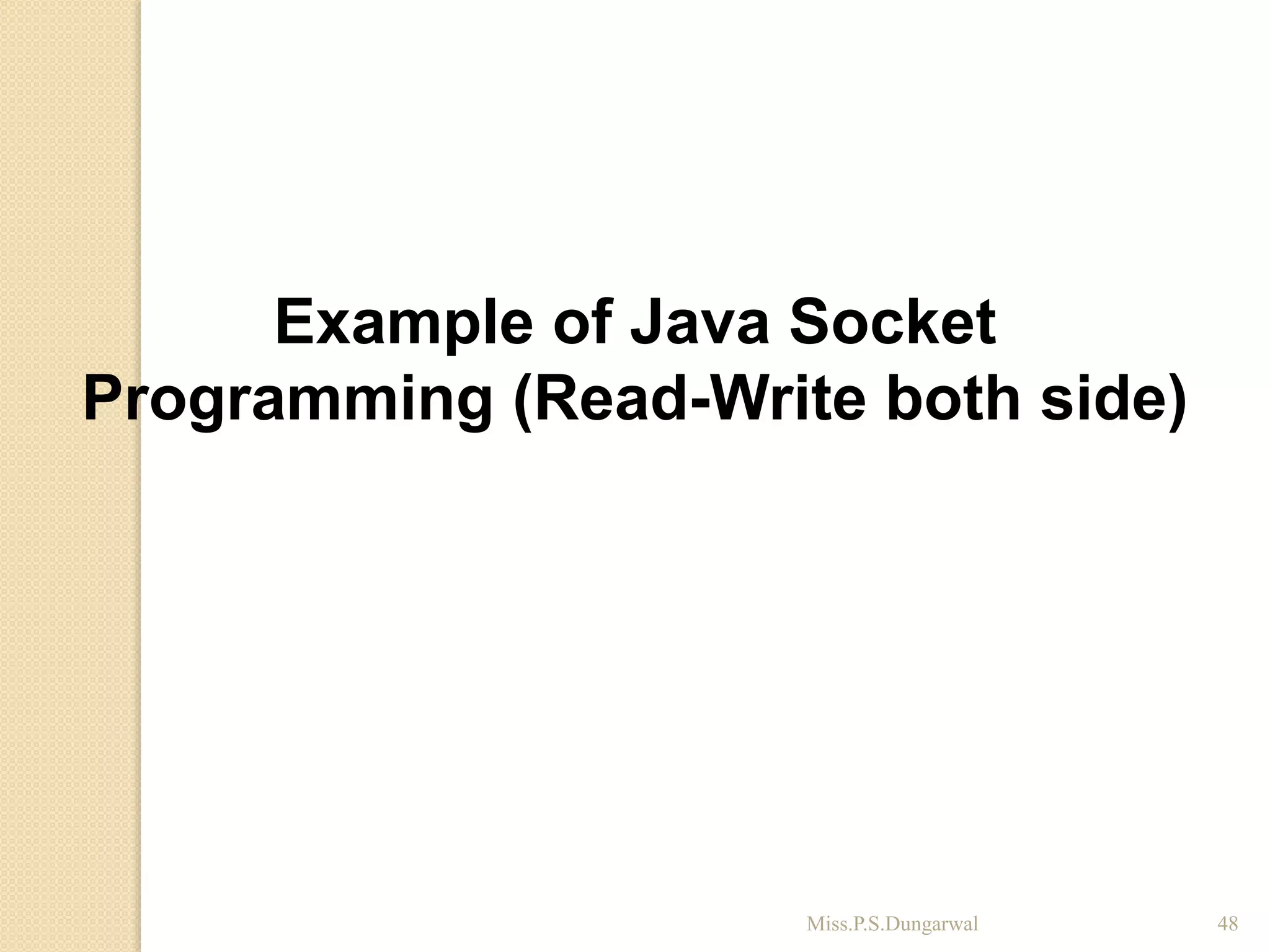
![import java.net.*;
import java.io.*;
class MyServer{
public static void main(String args[])throws Exception{
ServerSocket ss=new ServerSocket(3333);
Socket s=ss.accept();
DataInputStream din=new DataInputStream(s.getInputStream());
DataOutputStream dout=new DataOutputStream(s.getOutputStream());
BufferedReader br=new BufferedReader(new InputStreamReader(System.in)
);
String str="",str2="";
while(!str.equals("stop")){
str=din.readUTF();
System.out.println("client says: "+str);
str2=br.readLine();
dout.writeUTF(str2);
dout.flush();
}
din.close();
s.close();
ss.close();
MyServer.java
49Miss.P.S.Dungarwal](https://image.slidesharecdn.com/chapter-4-networking-200520081049/75/Advance-Java-Programming-CM5I-4-Networking-Basics-49-2048.jpg)
![import java.net.*;
import java.io.*;
class MyClient{
public static void main(String args[])throws Exception{
Socket s=new Socket("localhost",3333);
DataInputStream din=new DataInputStream(s.getInputStream());
DataOutputStream dout=new DataOutputStream(s.getOutputStream());
BufferedReader br=new BufferedReader(new InputStreamReader(System.in));
String str="",str2="";
while(!str.equals("stop")){
str=br.readLine();
dout.writeUTF(str);
dout.flush();
str2=din.readUTF();
System.out.println("Server says: "+str2);
}
dout.close();
s.close();
}}
MyClient.java
50Miss.P.S.Dungarwal](https://image.slidesharecdn.com/chapter-4-networking-200520081049/75/Advance-Java-Programming-CM5I-4-Networking-Basics-50-2048.jpg)
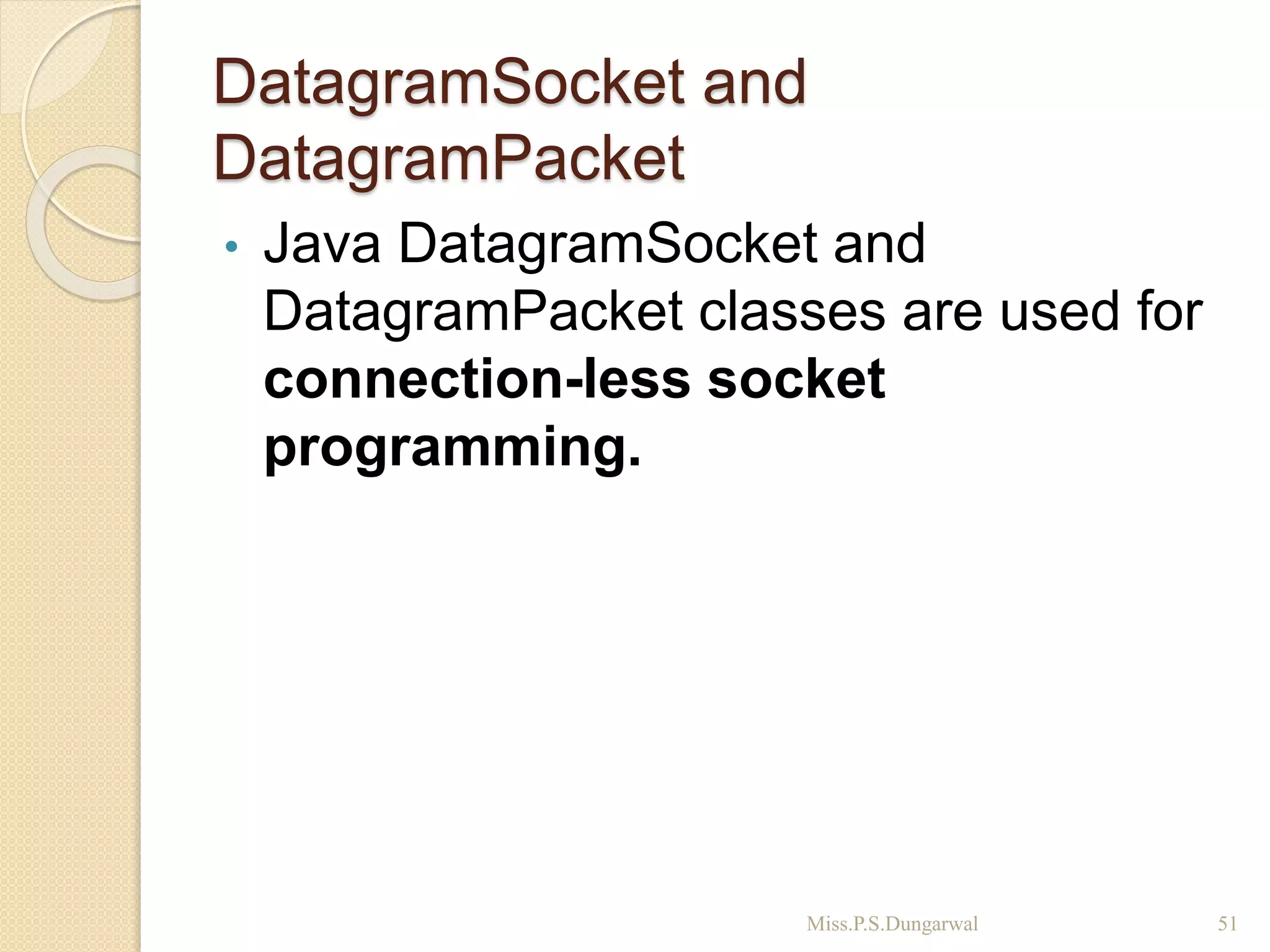
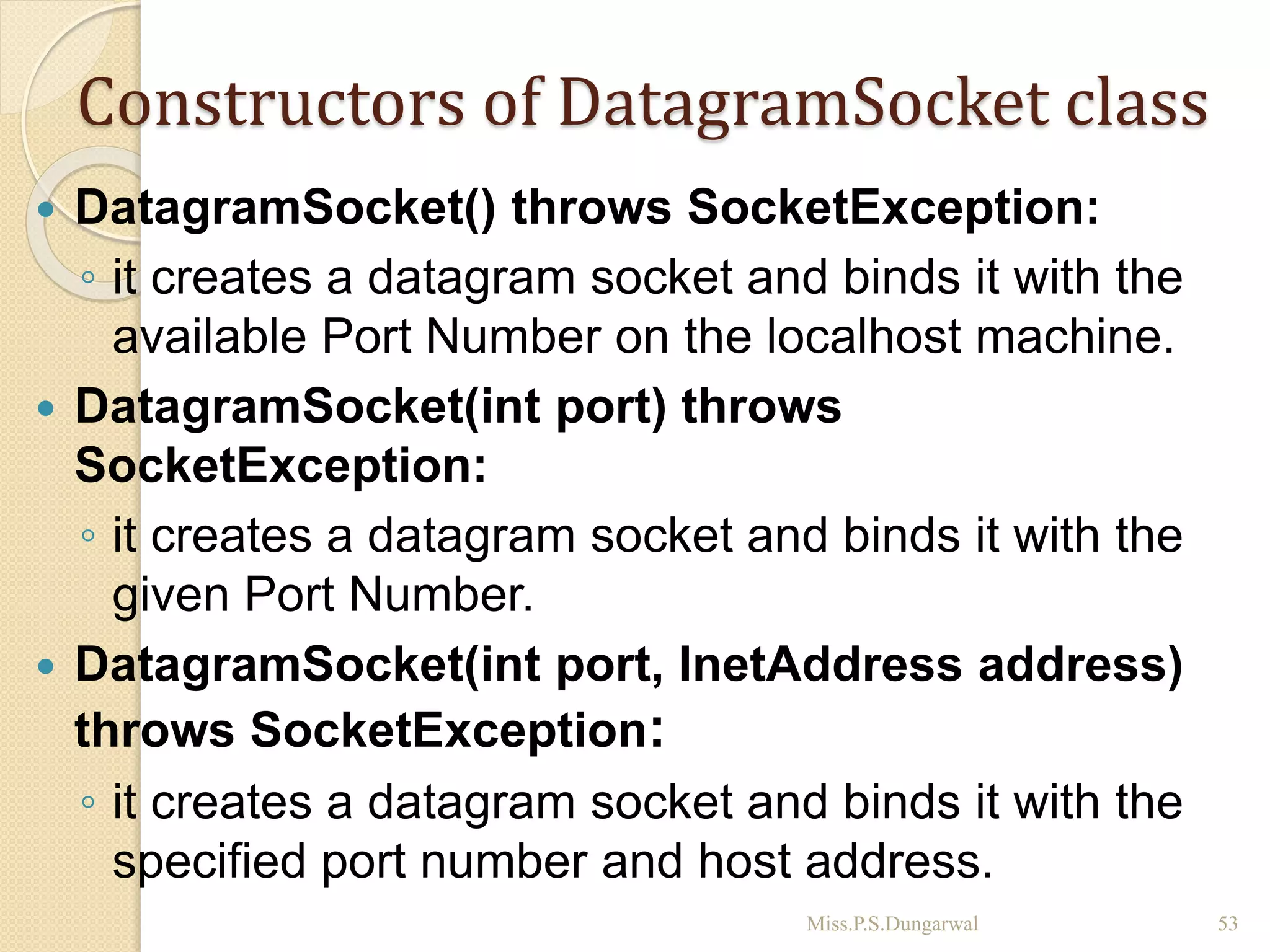
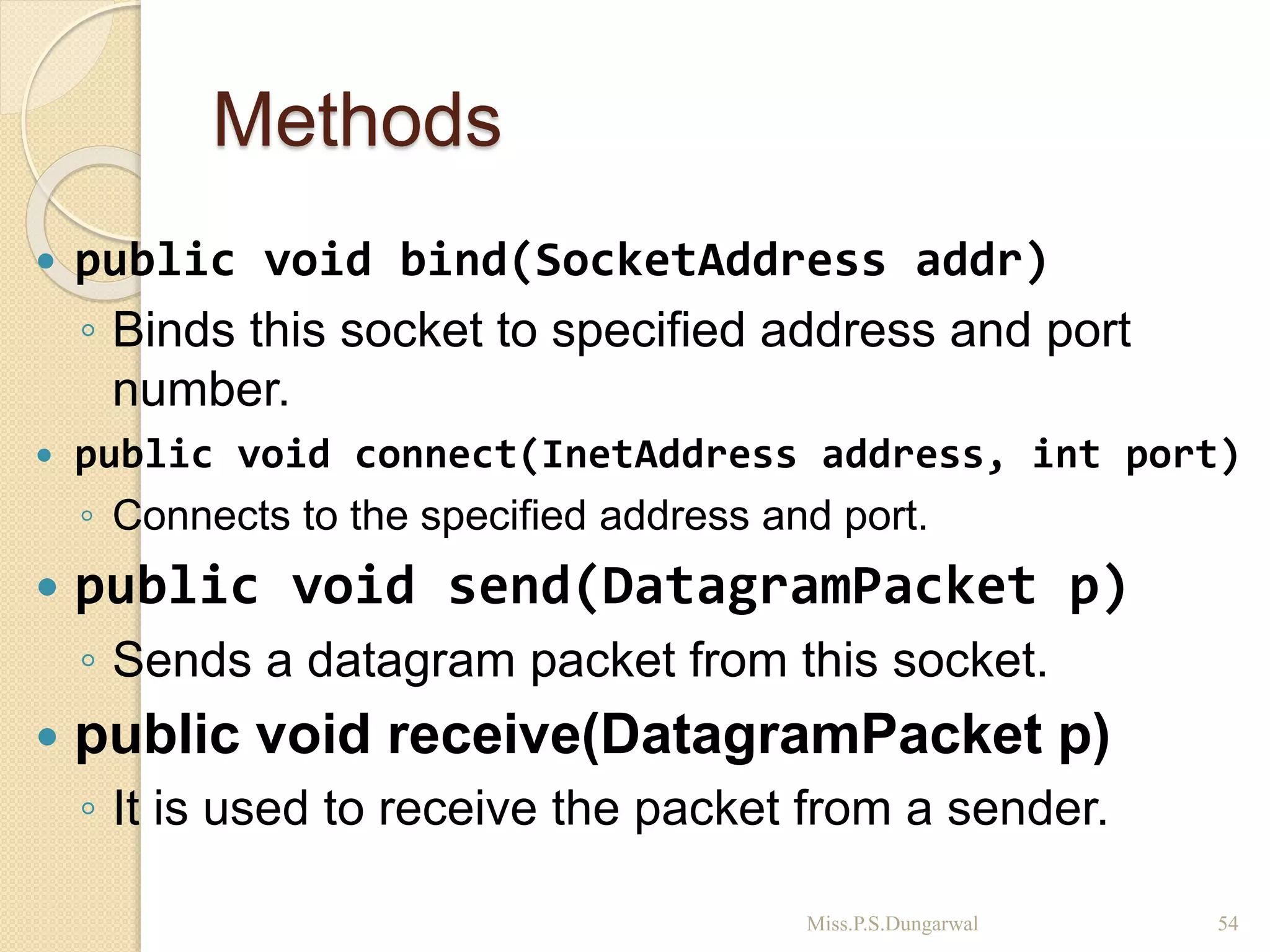
![DatagramPacket class
DatagramPacket is a message that can be sent or
received. If you send multiple packet, it may arrive
in any order.
Constructors
DatagramPacket(byte[] barr, int length):
◦ This constructor is used to receive the packets.
DatagramPacket(byte[] barr, int length,
InetAddress address, int port):
◦ This constructor is used to send the packets.
55Miss.P.S.Dungarwal](https://image.slidesharecdn.com/chapter-4-networking-200520081049/75/Advance-Java-Programming-CM5I-4-Networking-Basics-54-2048.jpg)
![import java.net.*;
public class DSender{
public static void main(String[] args) throws Excepti
on {
DatagramSocket ds = new DatagramSocket();
String str = "Welcome java";
InetAddress ip = InetAddress.getByName("127.0.0.1
");
DatagramPacket dp = new DatagramPacket(str.ge
tBytes(), str.length(), ip, 3000);
ds.send(dp);
ds.close();
}
} 56Miss.P.S.Dungarwal](https://image.slidesharecdn.com/chapter-4-networking-200520081049/75/Advance-Java-Programming-CM5I-4-Networking-Basics-55-2048.jpg)
![import java.net.*;
public class DReceiver{
public static void main(String[] args) throws Exception {
DatagramSocket ds = new DatagramSocket(3000);
byte[] buf = new byte[1024];
DatagramPacket dp = new DatagramPacket(buf, 1024);
ds.receive(dp);
String str = new String(dp.getData(), 0, dp.getLength());
System.out.println(str);
ds.close();
}
}
57Miss.P.S.Dungarwal](https://image.slidesharecdn.com/chapter-4-networking-200520081049/75/Advance-Java-Programming-CM5I-4-Networking-Basics-56-2048.jpg)
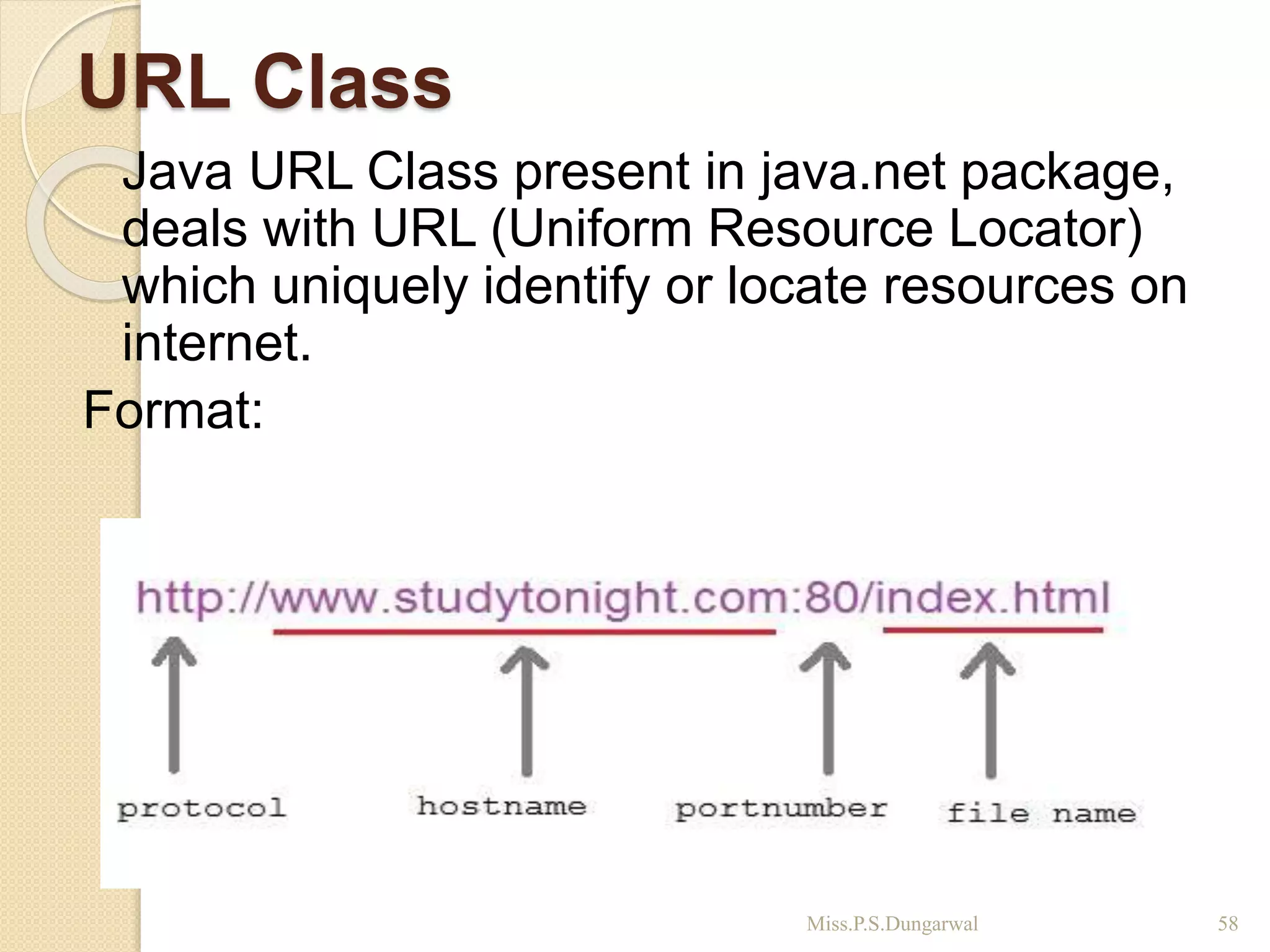
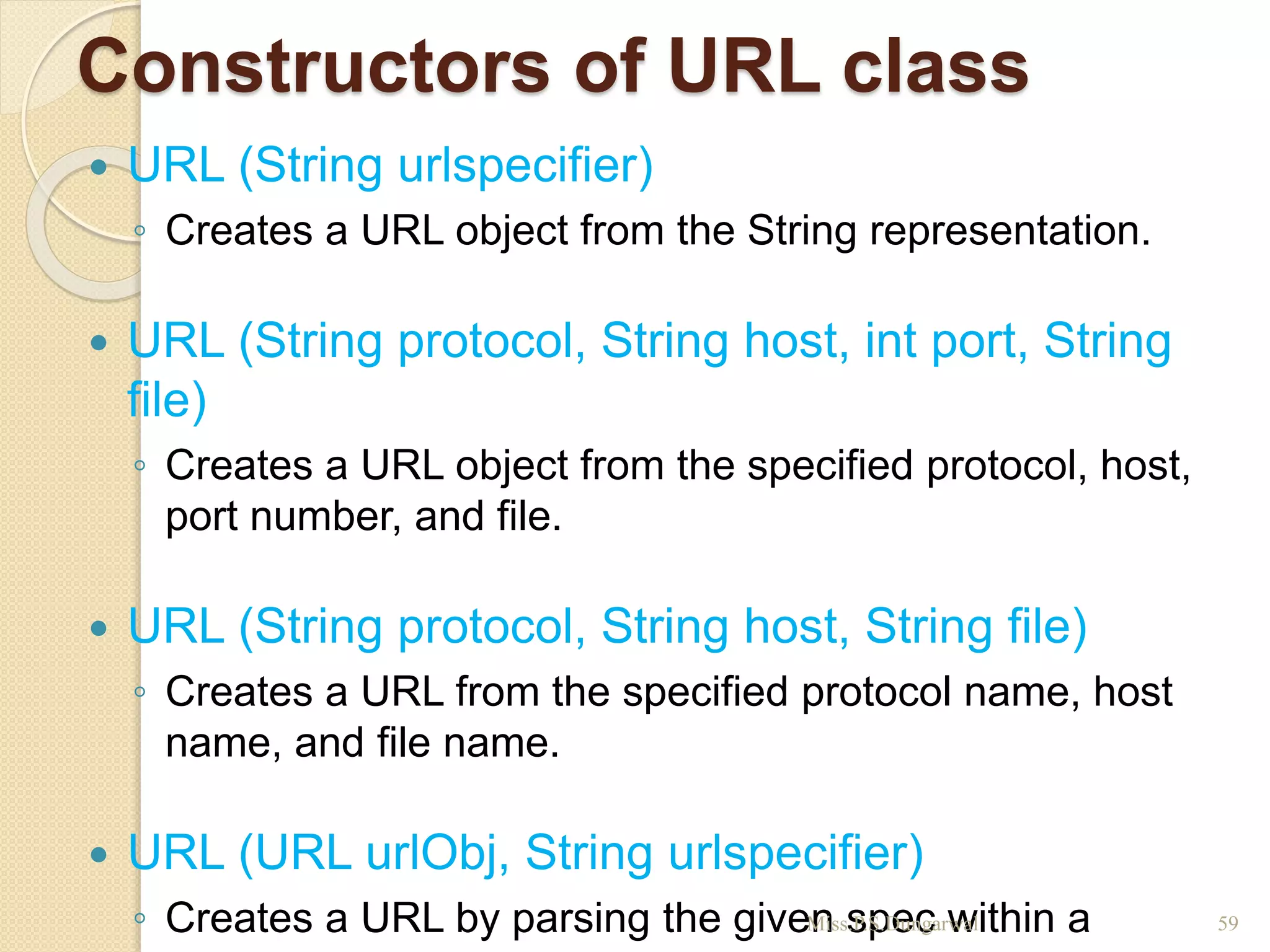
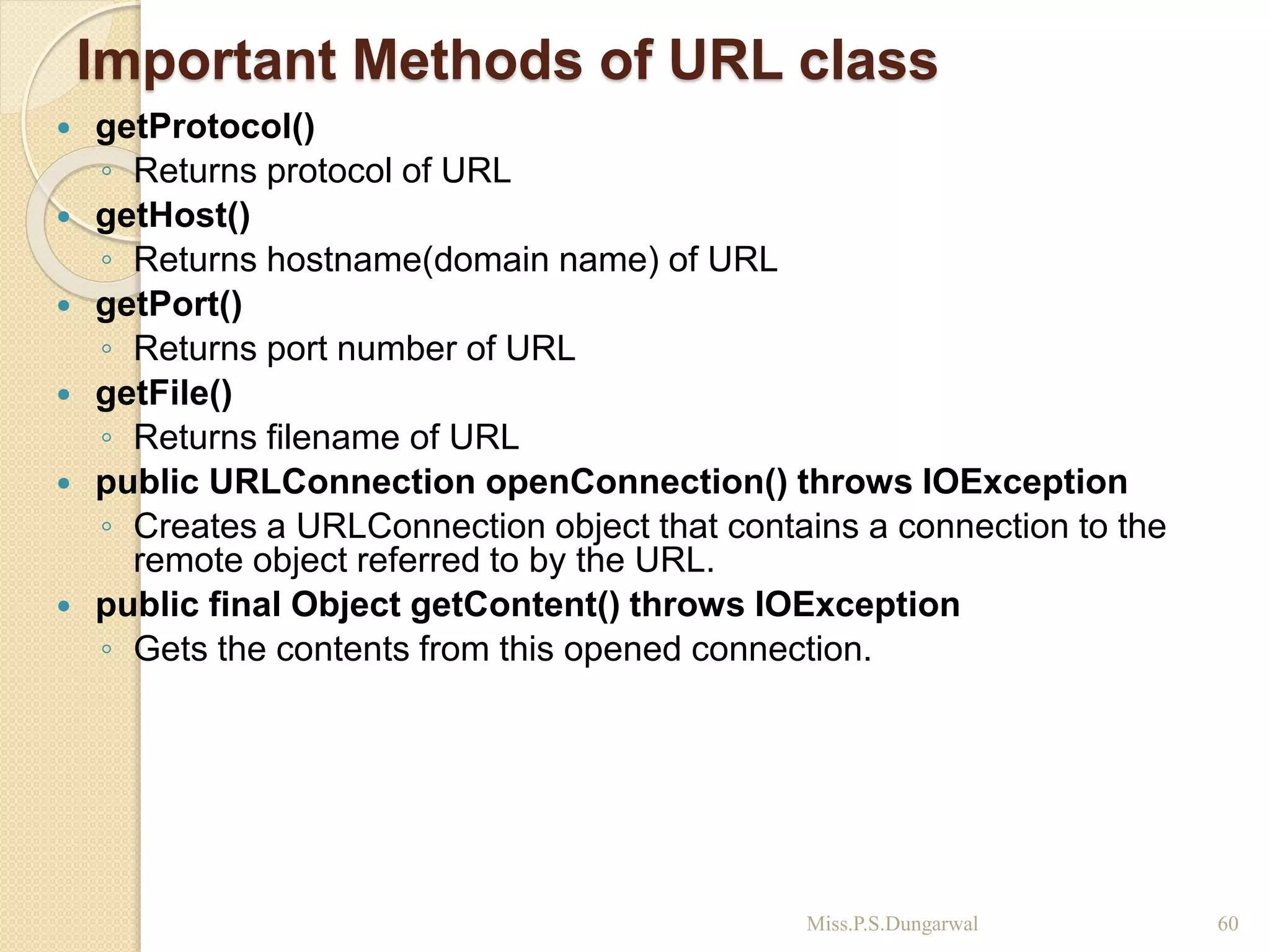
![import java.net.*;
public class URLDemo{
public static void main(String[] args){
try{
URL url=new
URL("https://www.google.com/search?q=javatpoint&o
q=javatpoint& sourceid=chrome&ie=UTF-8");
System.out.println("Protocol: "+url.getProtocol());
System.out.println("Host Name: "+url.getHost());
System.out.println("Port Number: "+url.getPort());
System.out.println("Default Port Number:
"+url.getDefaultPort());
System.out.println("Query String: "+url.getQuery());
System.out.println("Path: "+url.getPath());
System.out.println("File: "+url.getFile());
} catch(Exception e){System.out.println(e);}
} }
Protocol: https
Host Name: www.google.com
Port Number: -1
Default Port Number: 443
Query String: q=javatpoint&oq=javatpoint&sourceid=chrome&ie=UTF-8
Path: /search
File: /search?q=javatpoint&oq=javatpoint&sourceid=chrome&ie=UTF-8
61Miss.P.S.Dungarwal](https://image.slidesharecdn.com/chapter-4-networking-200520081049/75/Advance-Java-Programming-CM5I-4-Networking-Basics-60-2048.jpg)
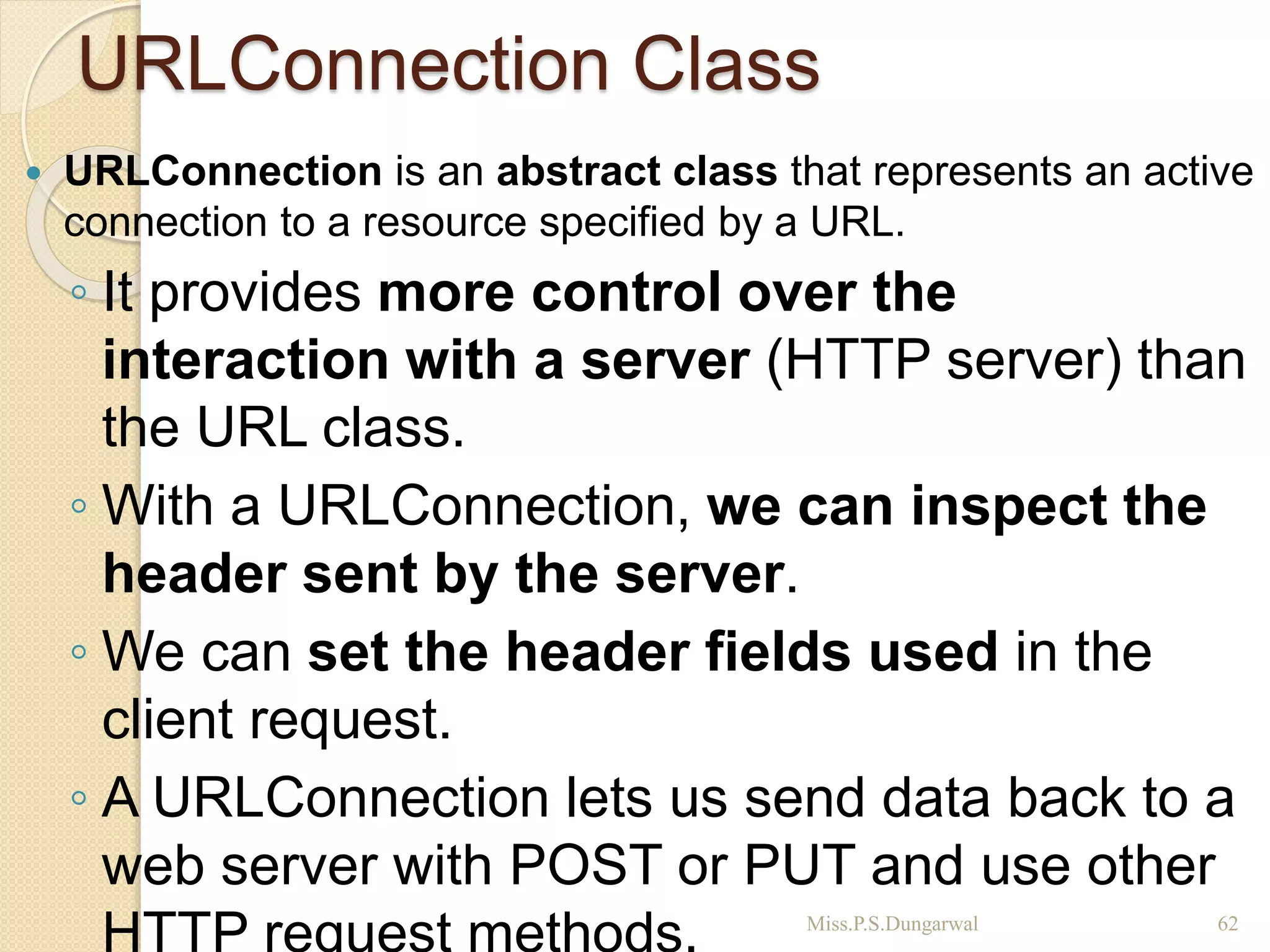
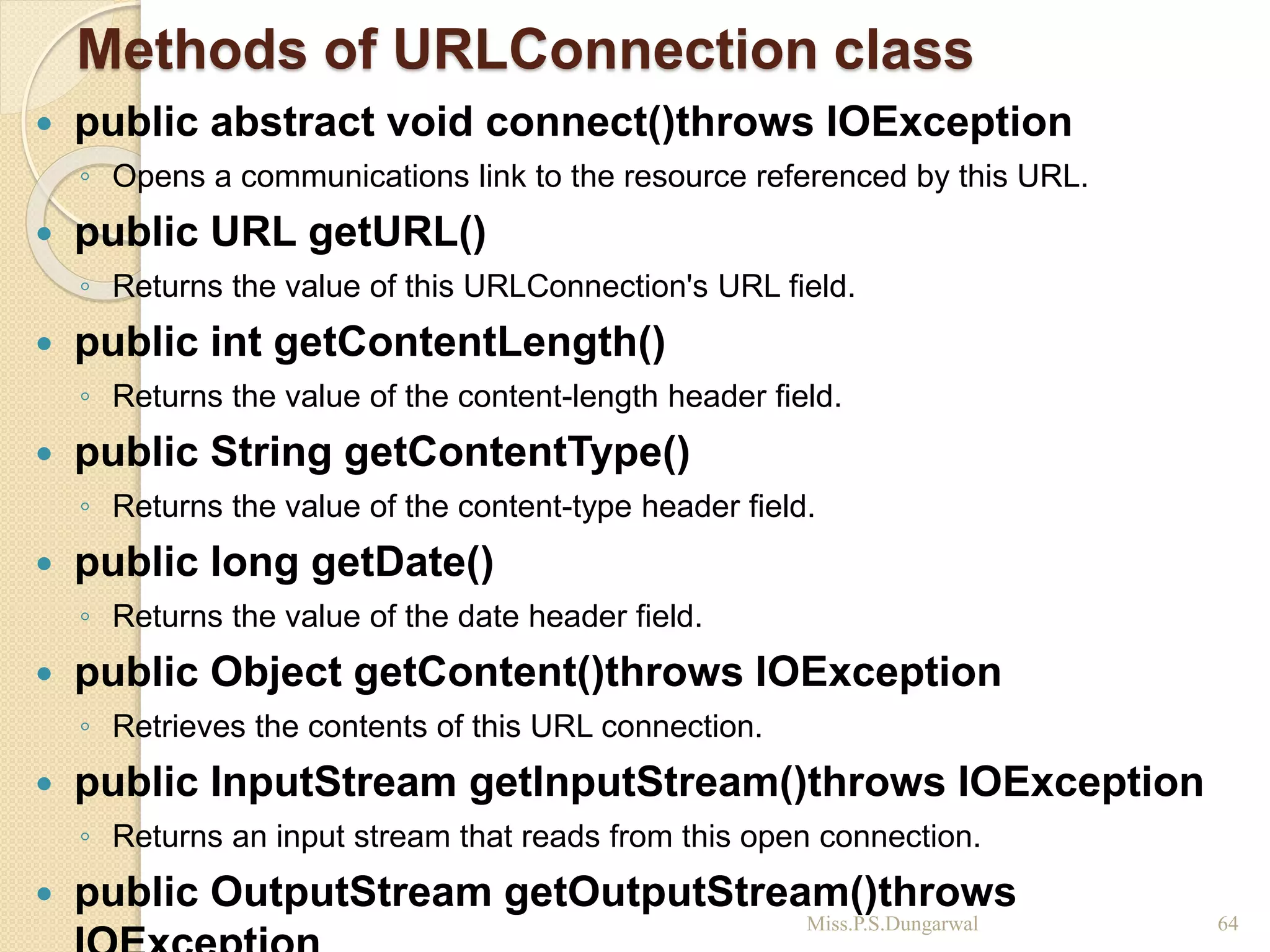
![import java.io.*;
import java.net.*;
public class URLConnectionExample {
public static void main(String[] args){
try{
URL url=new URL("http://www.javatpoint.com/java-tutorial");
URLConnection urlcon=url.openConnection();
InputStream stream=urlcon.getInputStream();
int i;
while((i=stream.read())!=-1){
System.out.print((char)i);
} }catch(Exception e){System.out.println(e);}
} }
<!DOCTYPE HTML PUBLIC "-//IETF//DTD HTML 2.0//EN">
<html><head>
<title>302 Found</title>
</head><body>
<h1>Found</h1>
<p>The document has moved <a href="https://www.javatpoint.com/java-
tutorial">here</a>.</p>
</body></html>
65Miss.P.S.Dungarwal](https://image.slidesharecdn.com/chapter-4-networking-200520081049/75/Advance-Java-Programming-CM5I-4-Networking-Basics-63-2048.jpg)